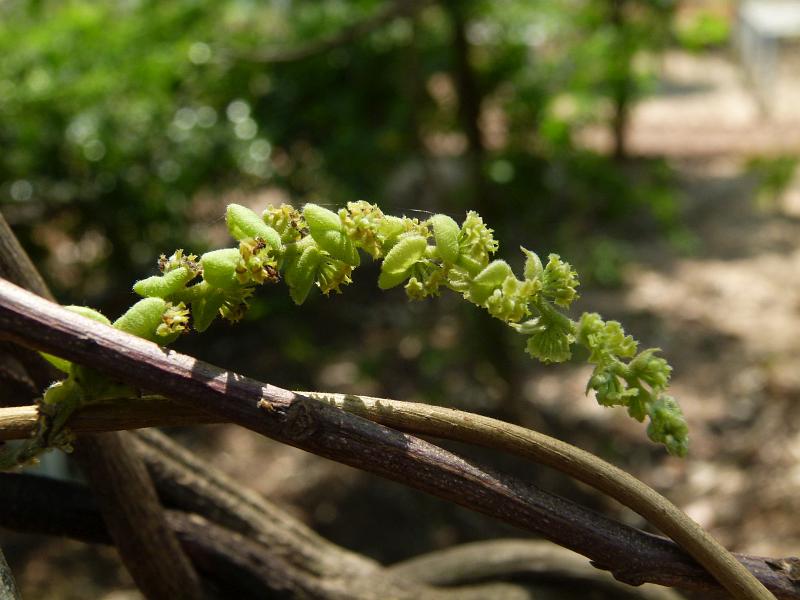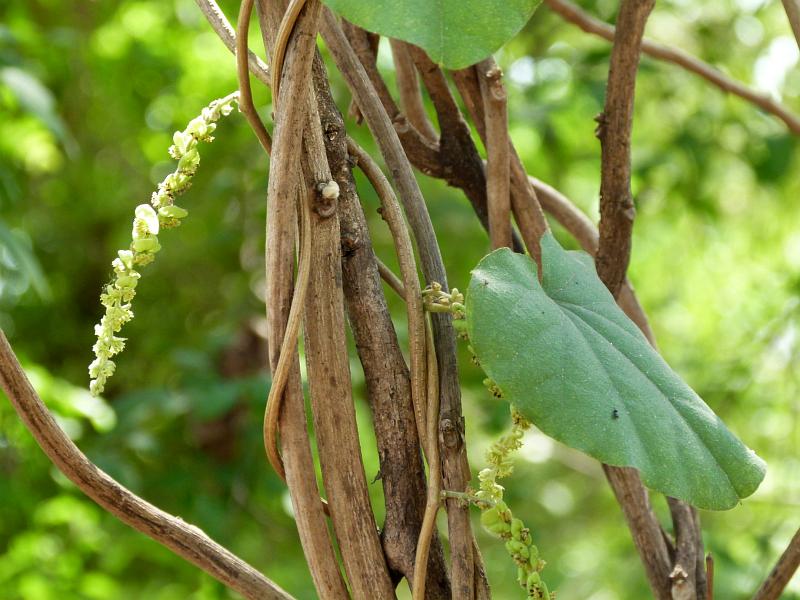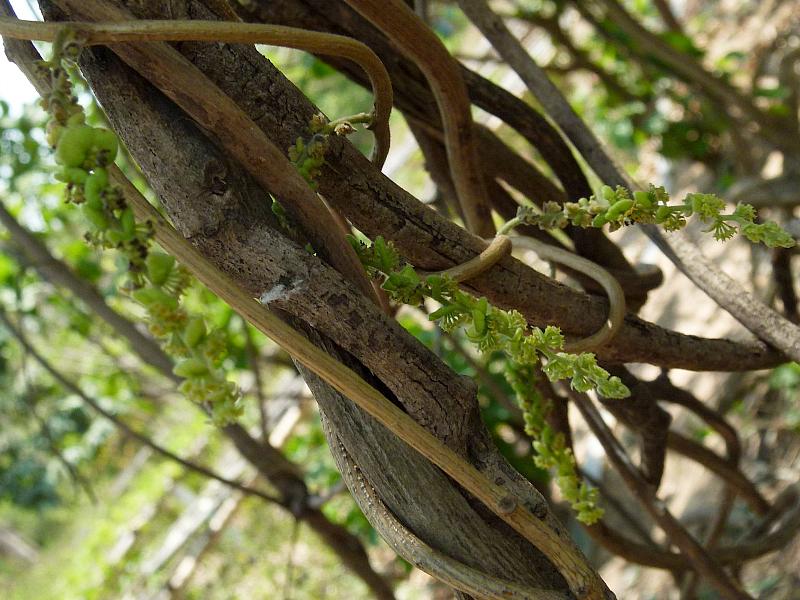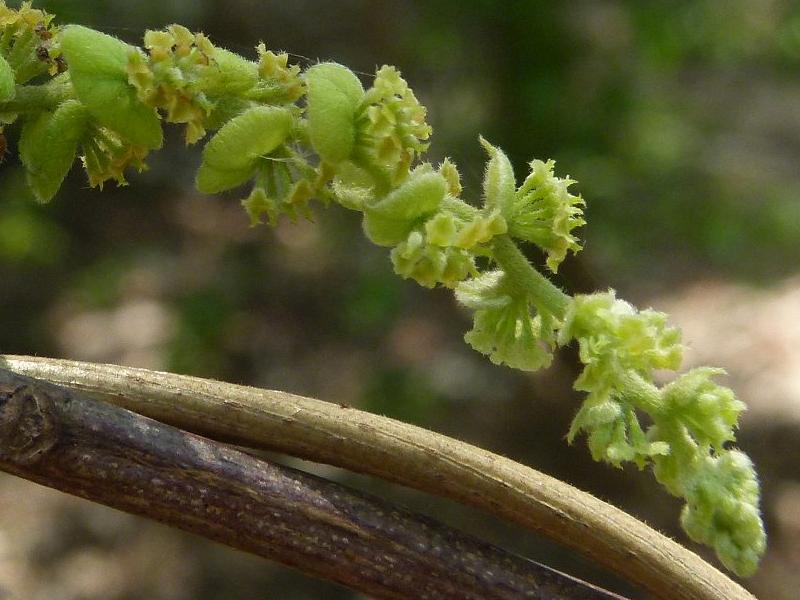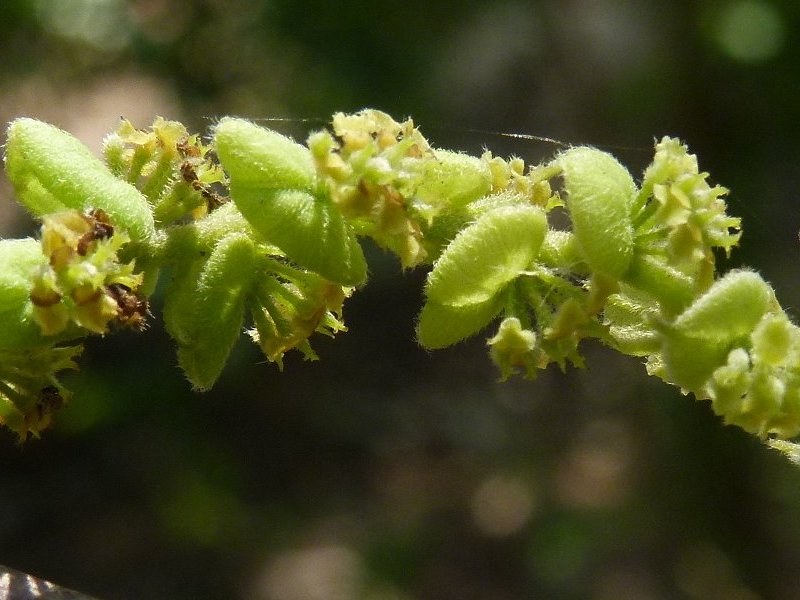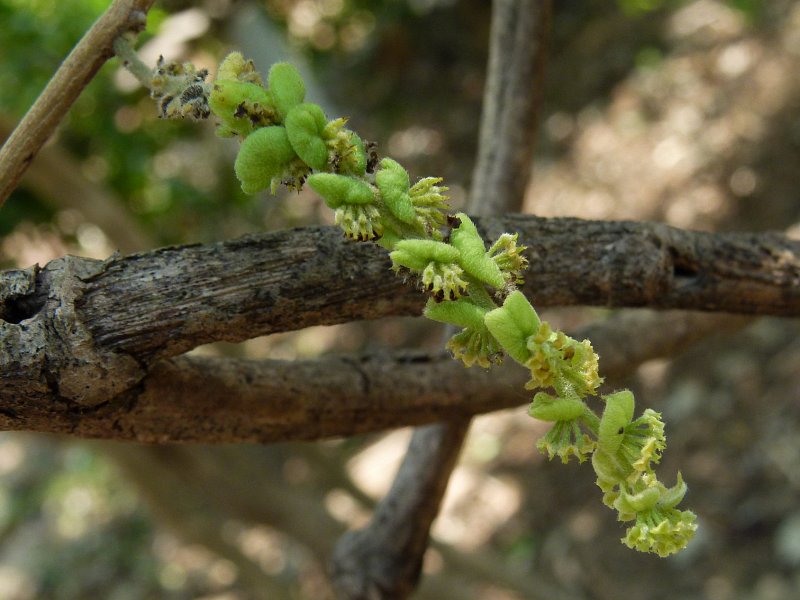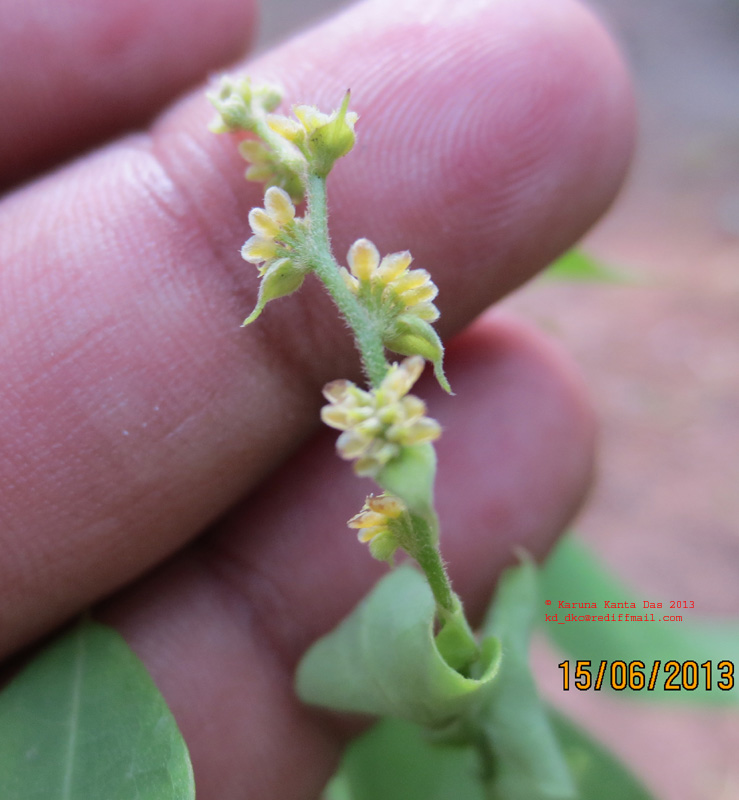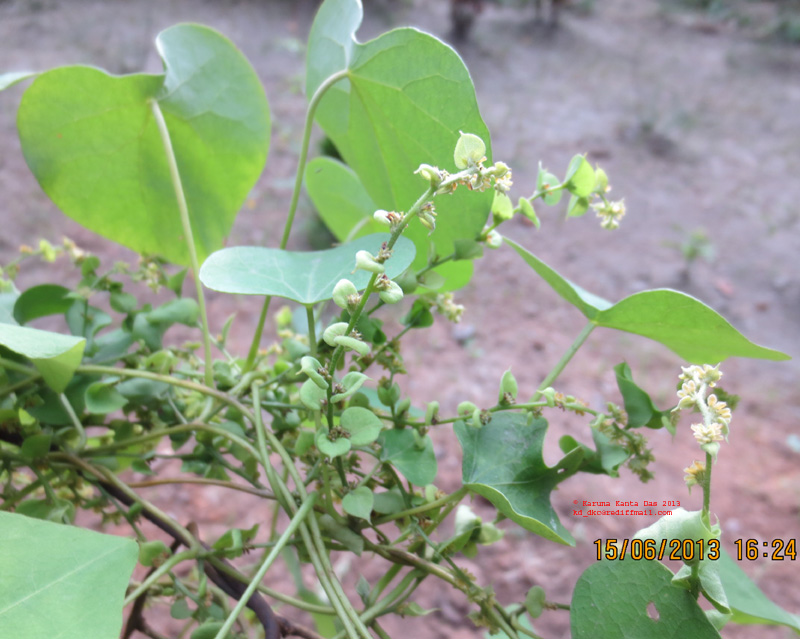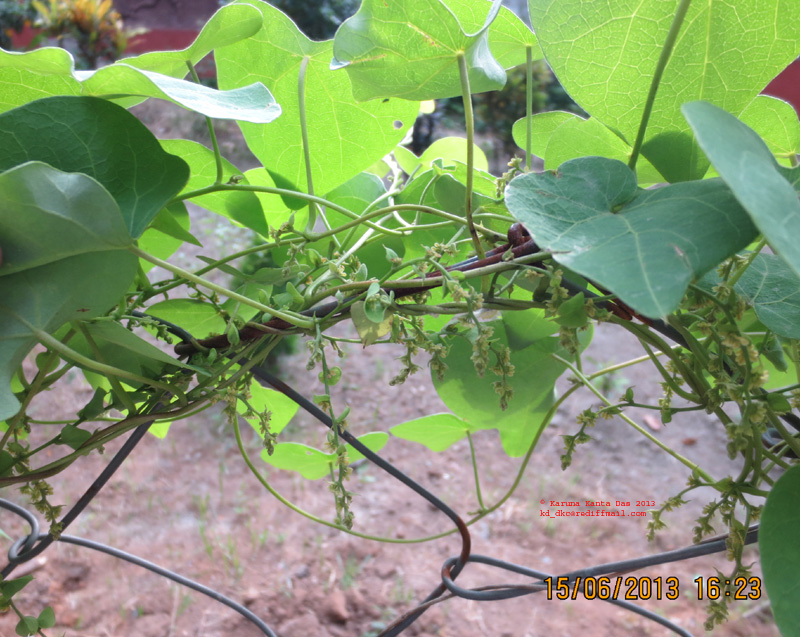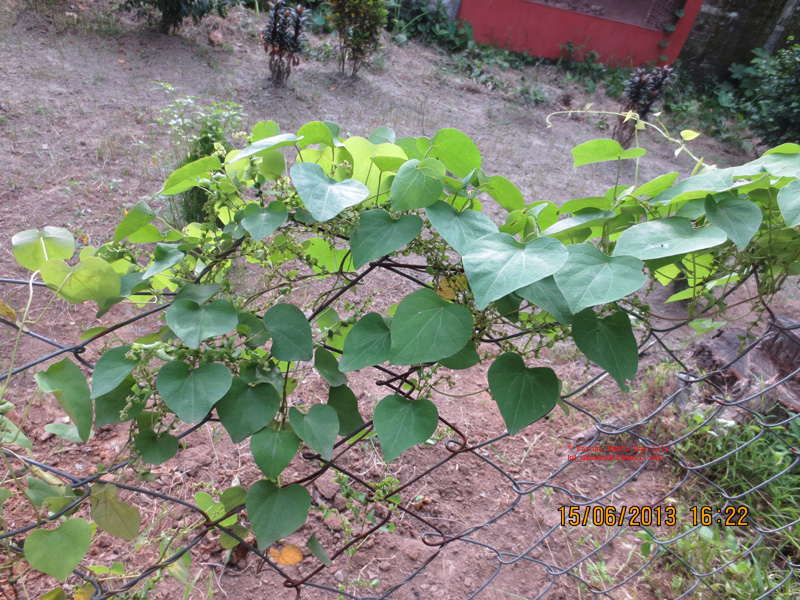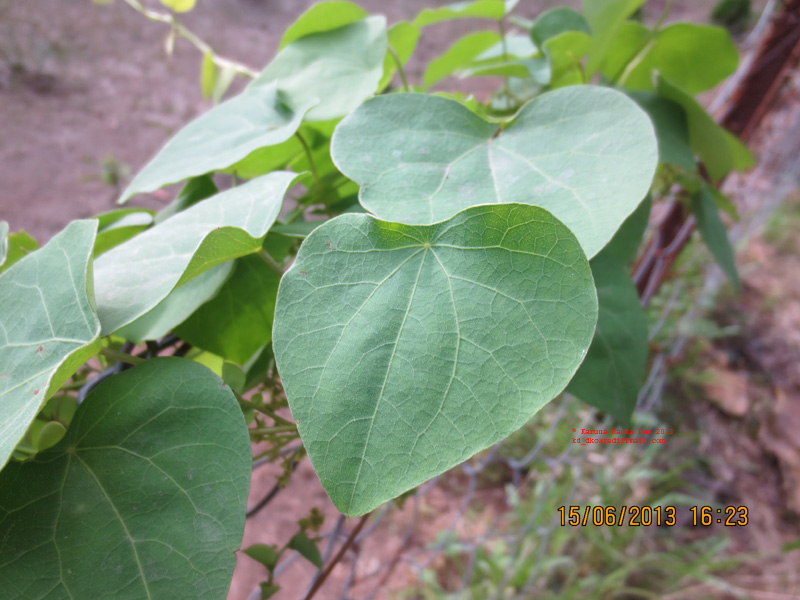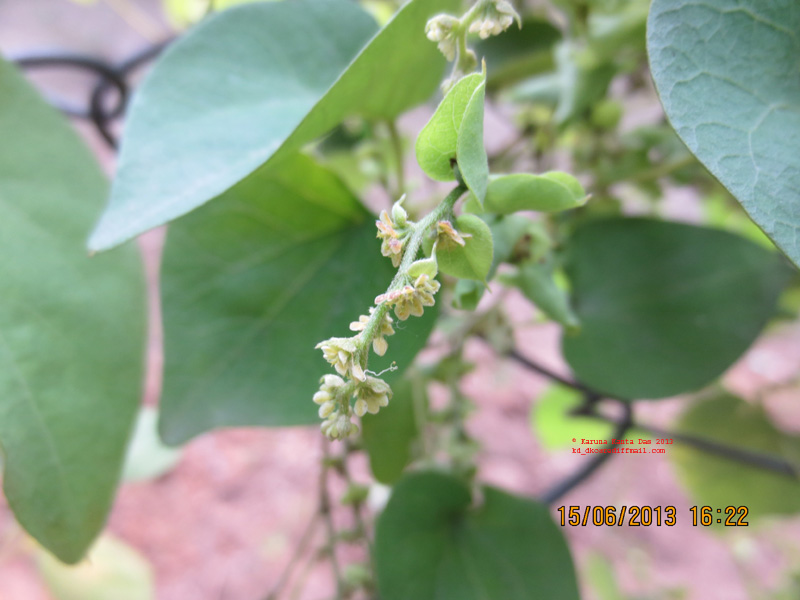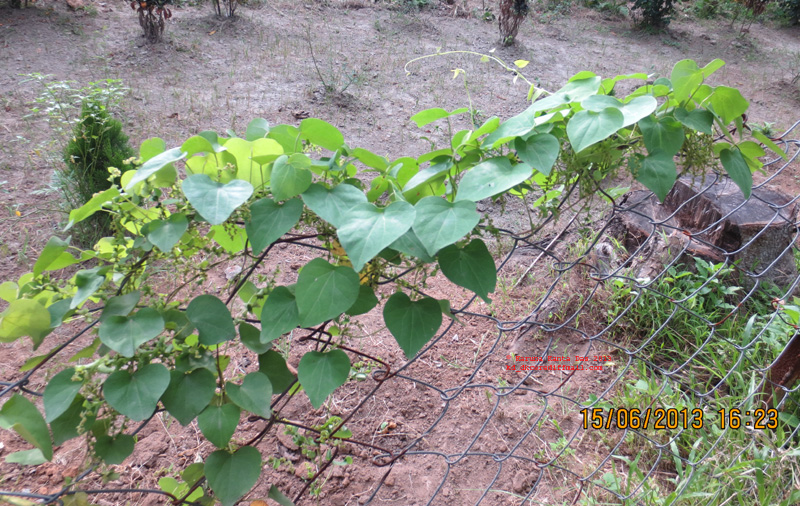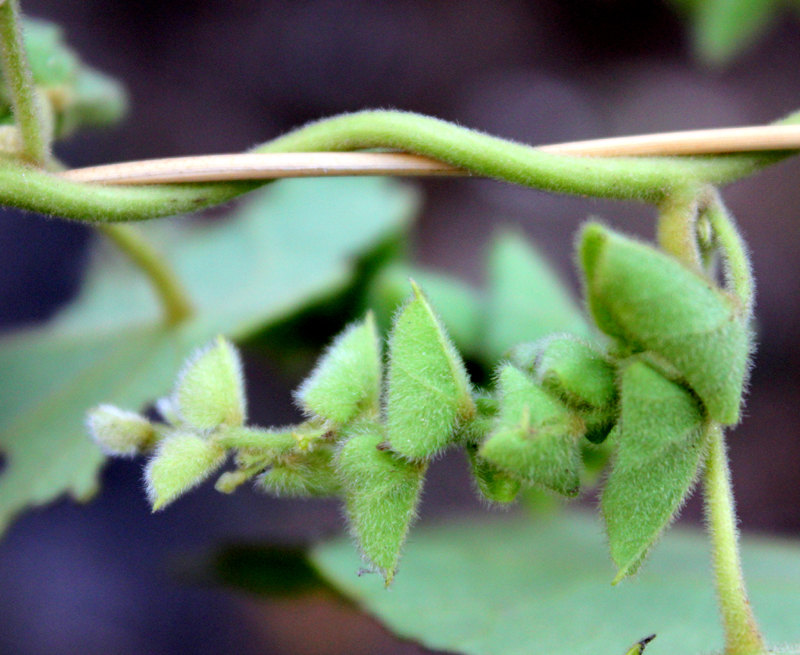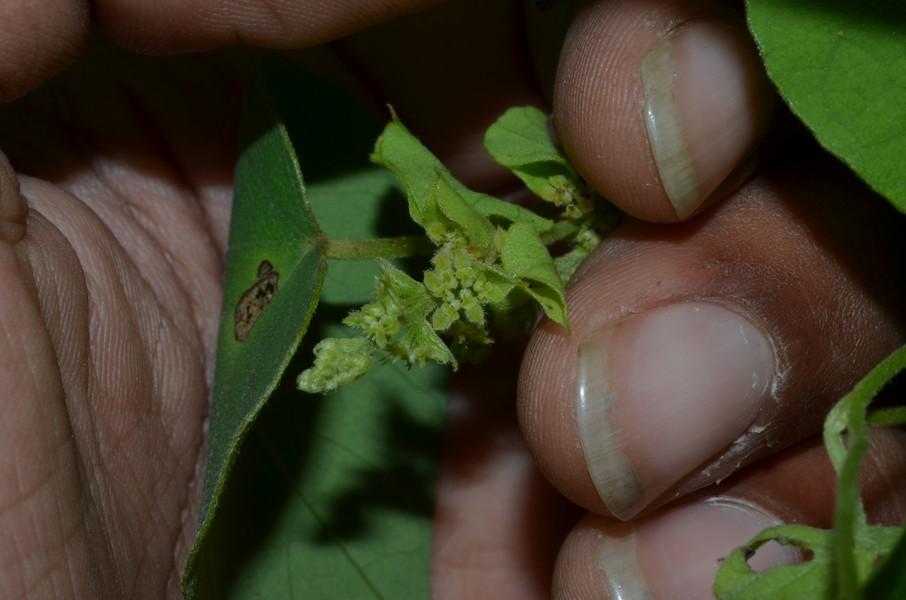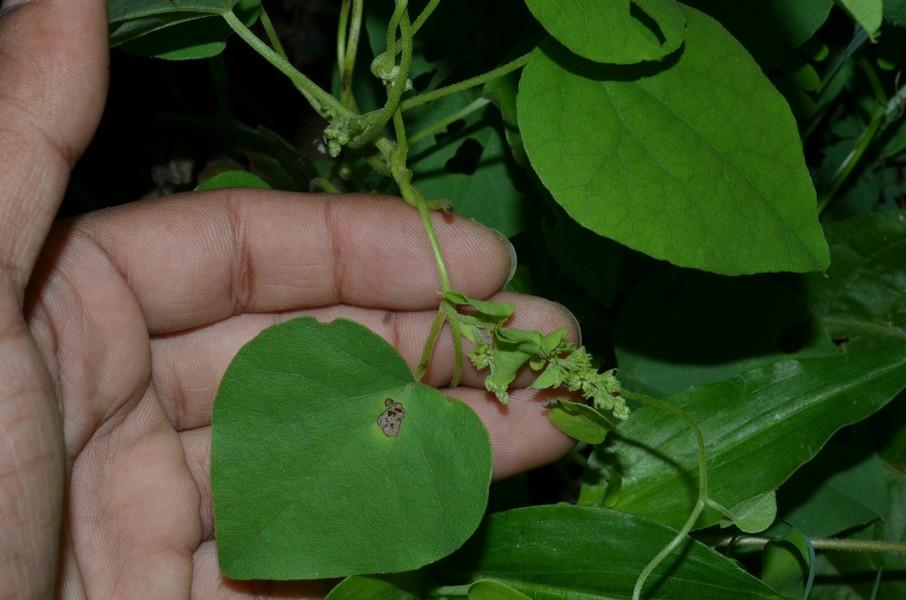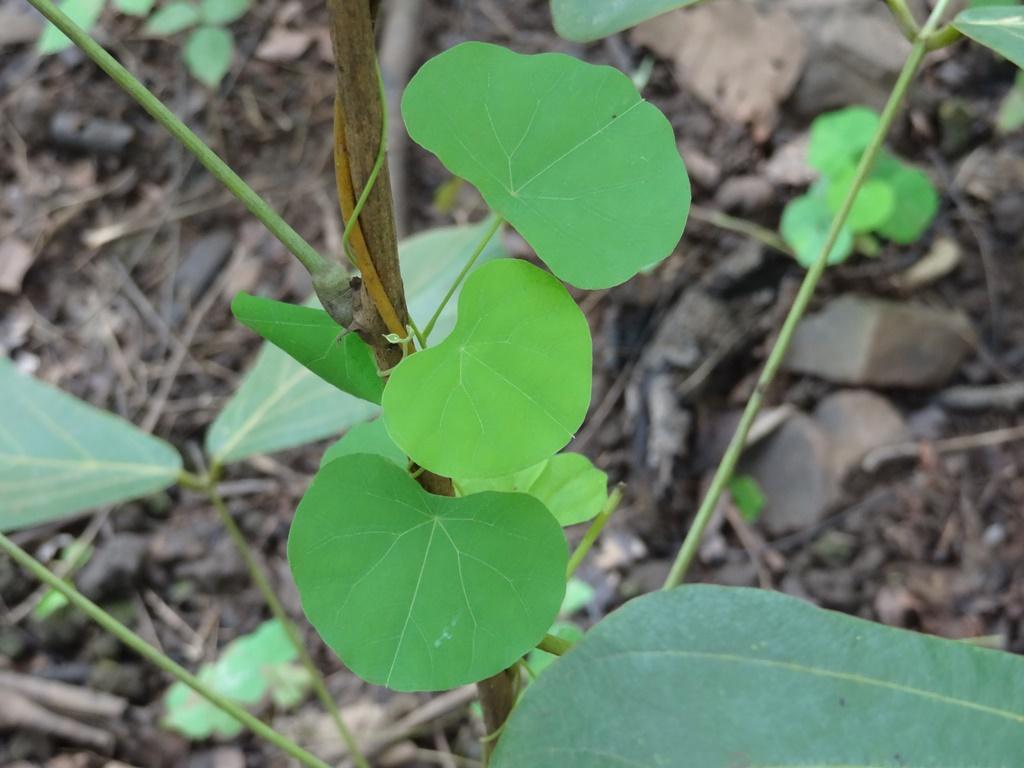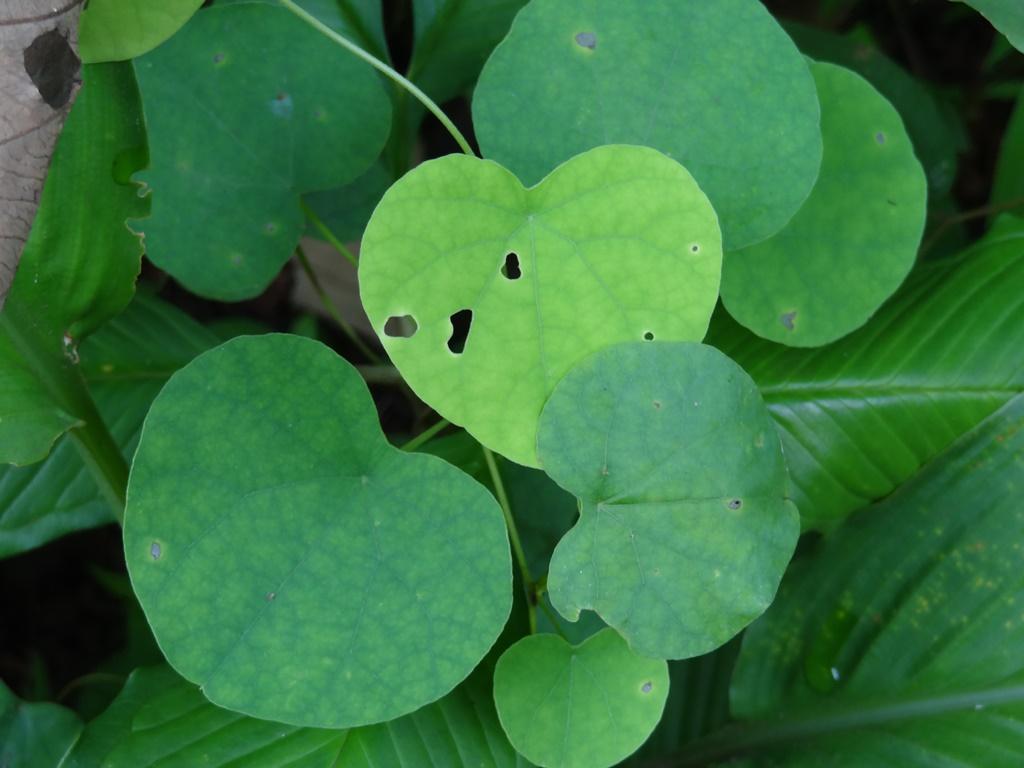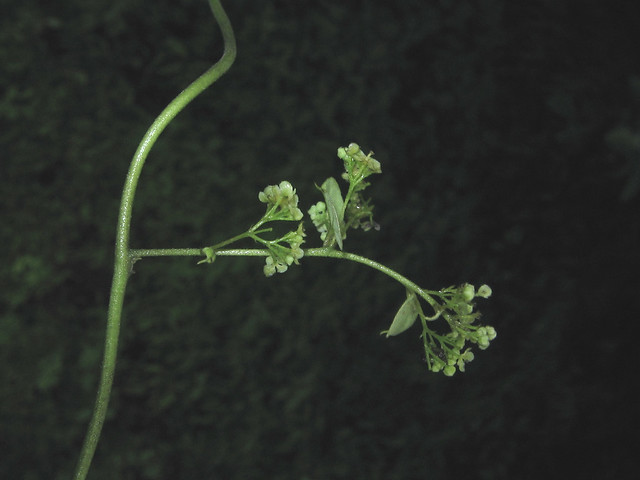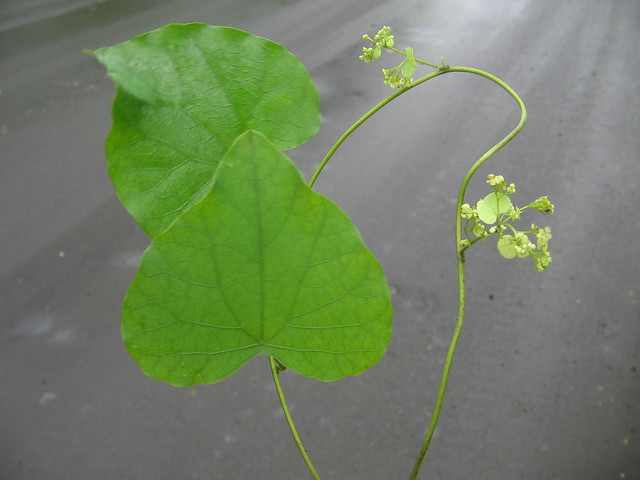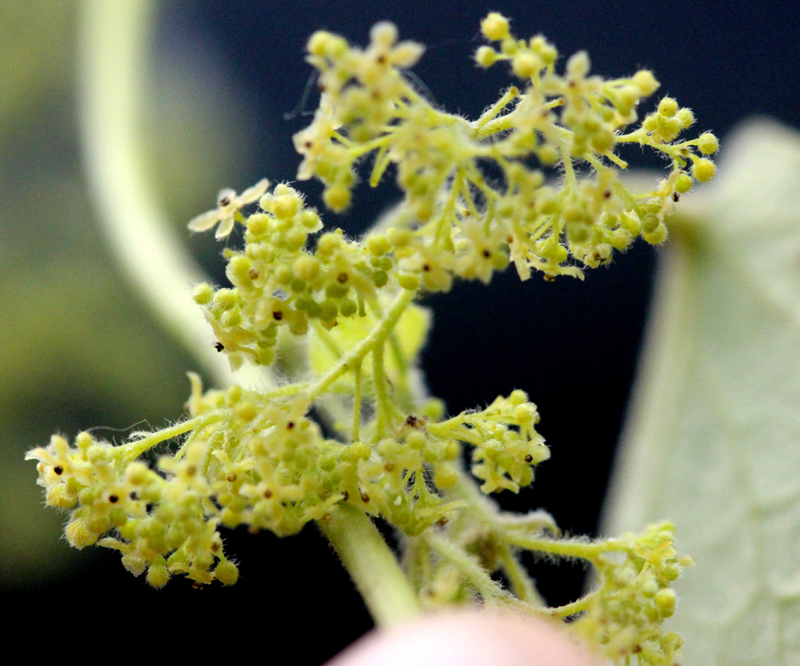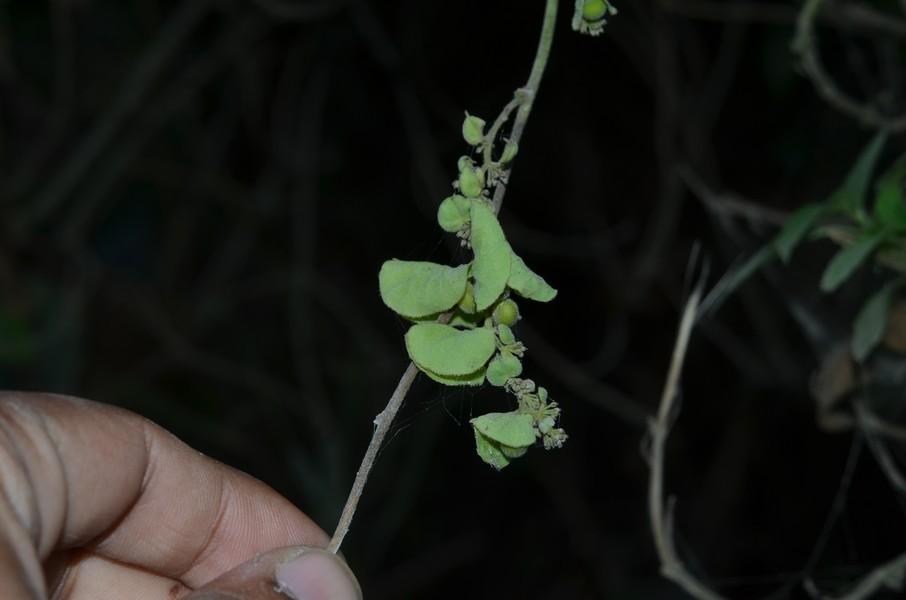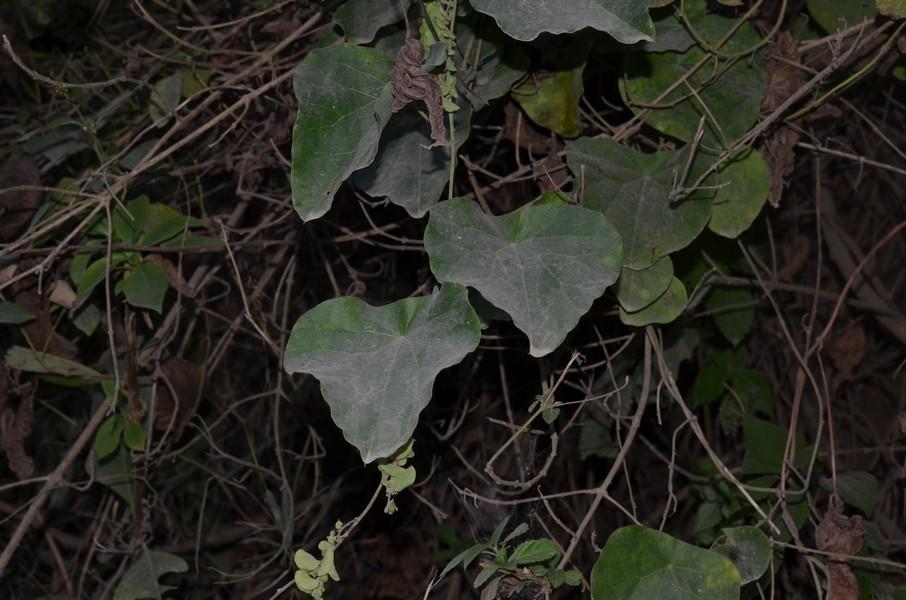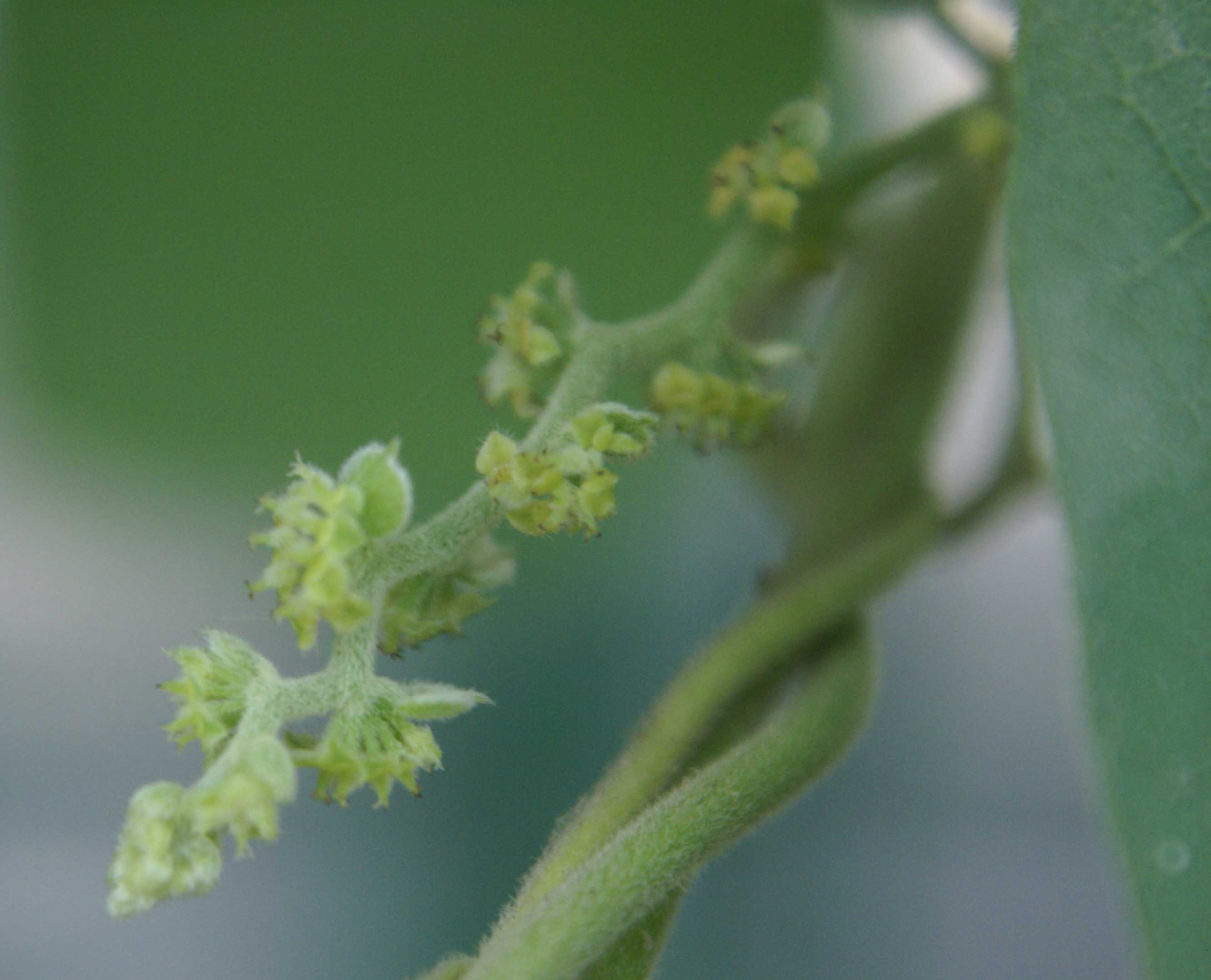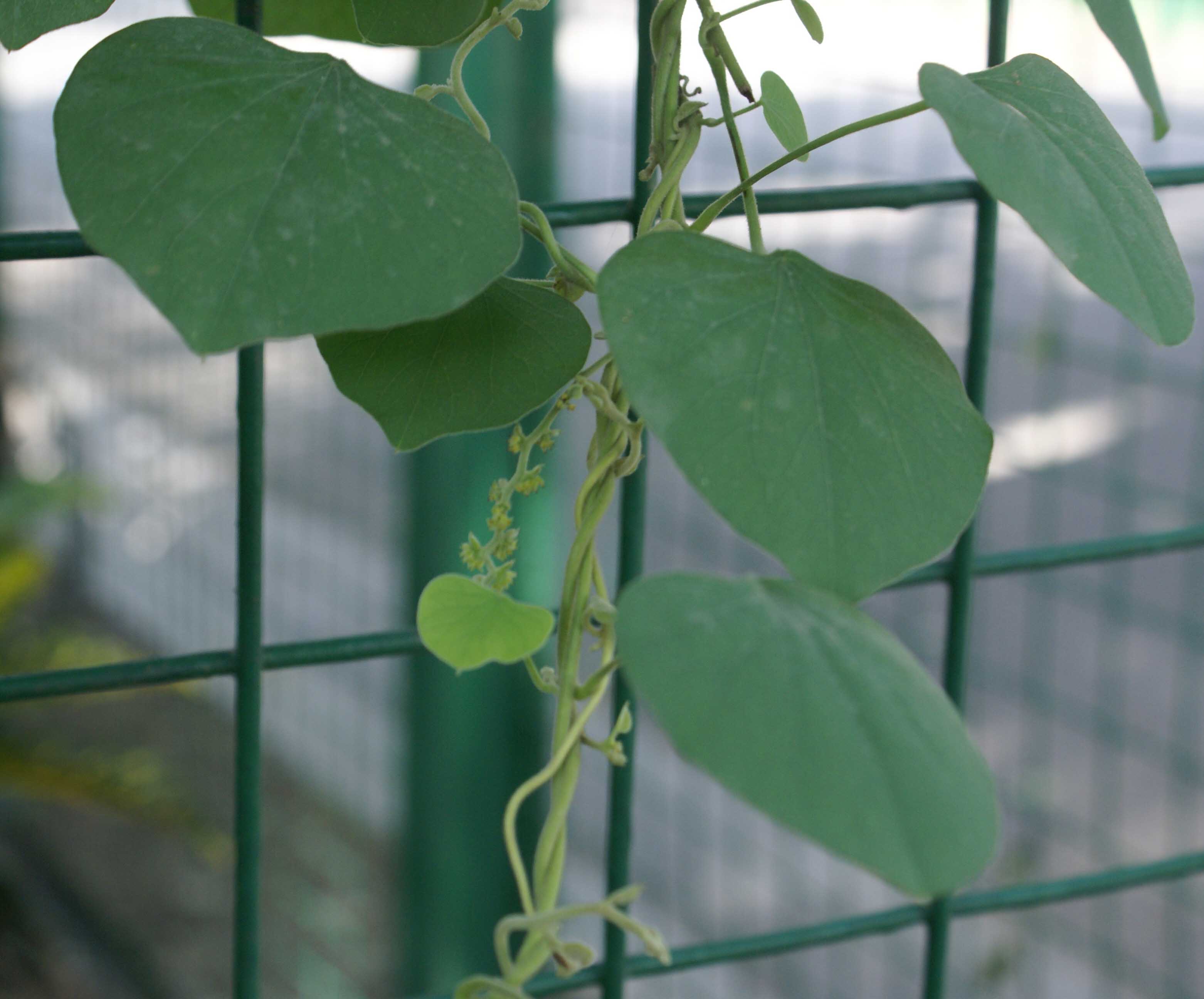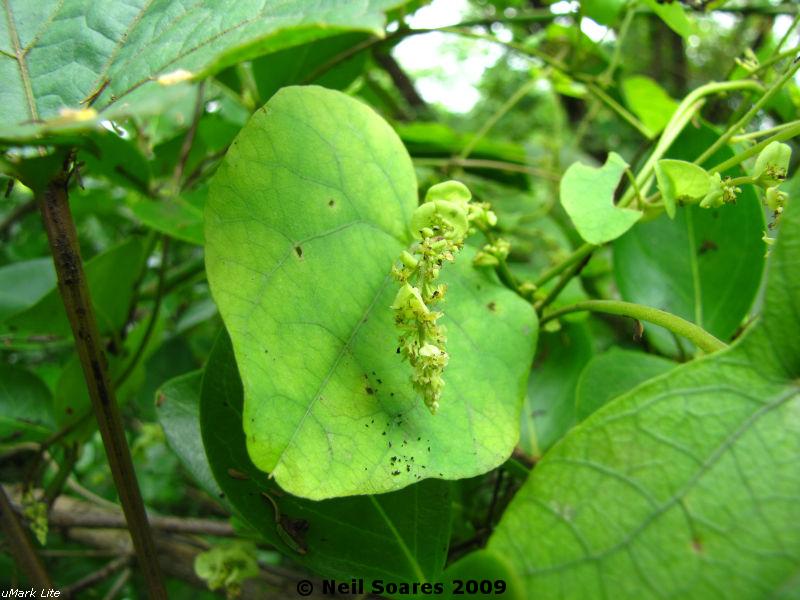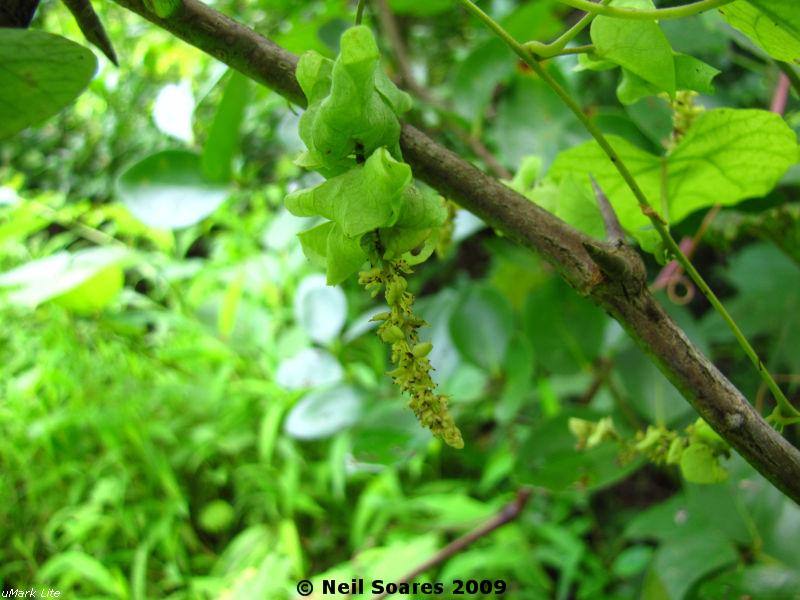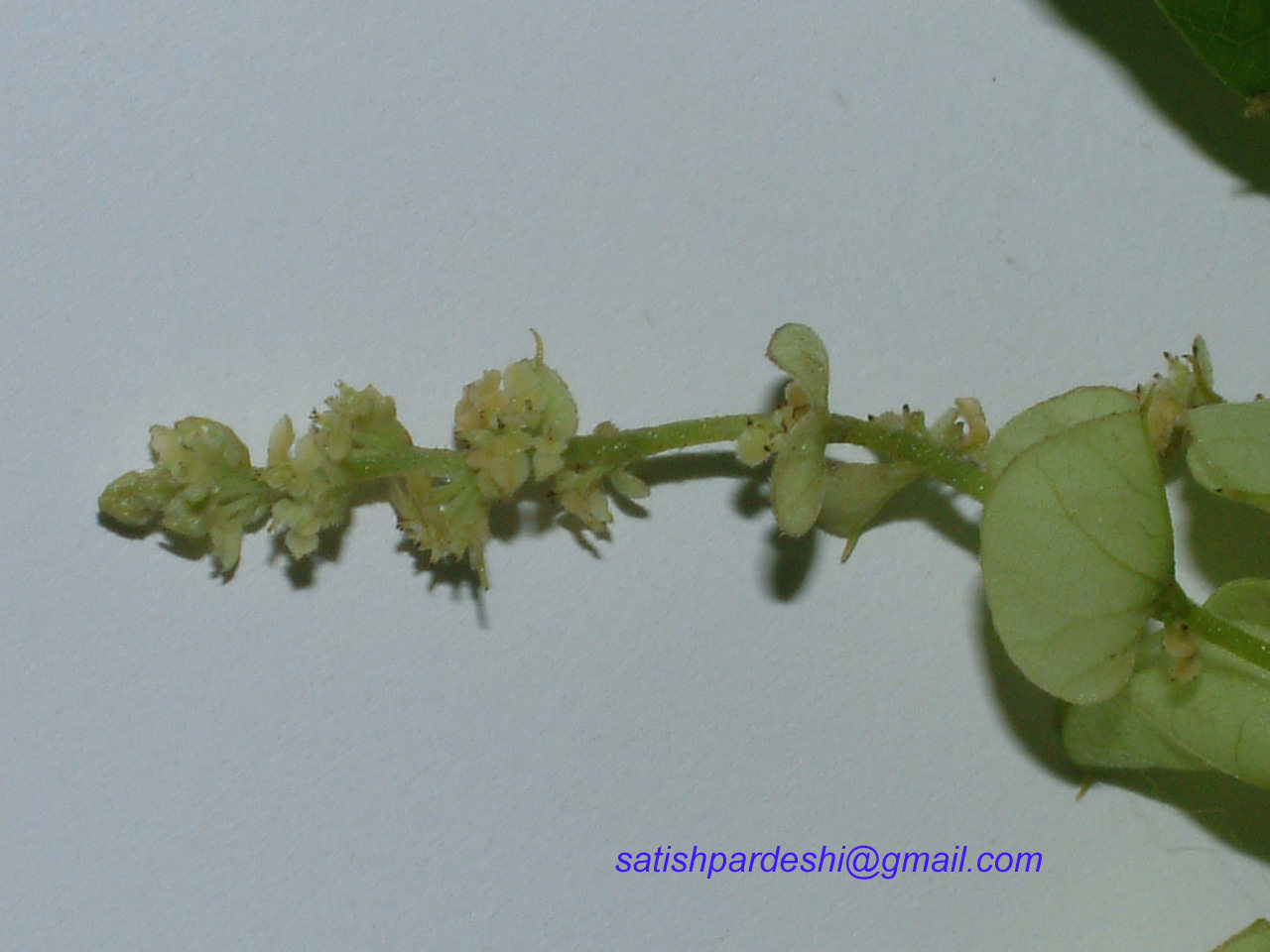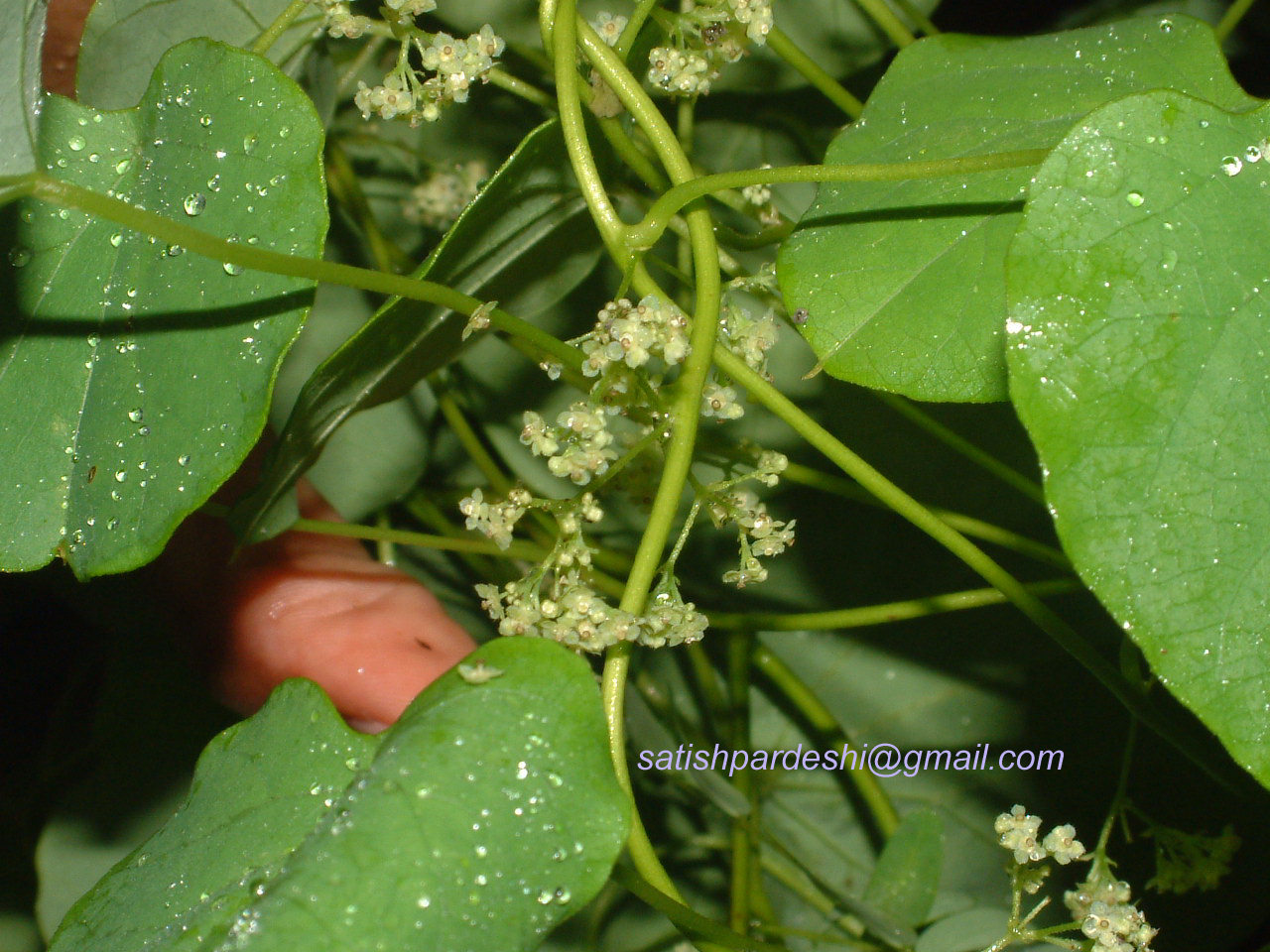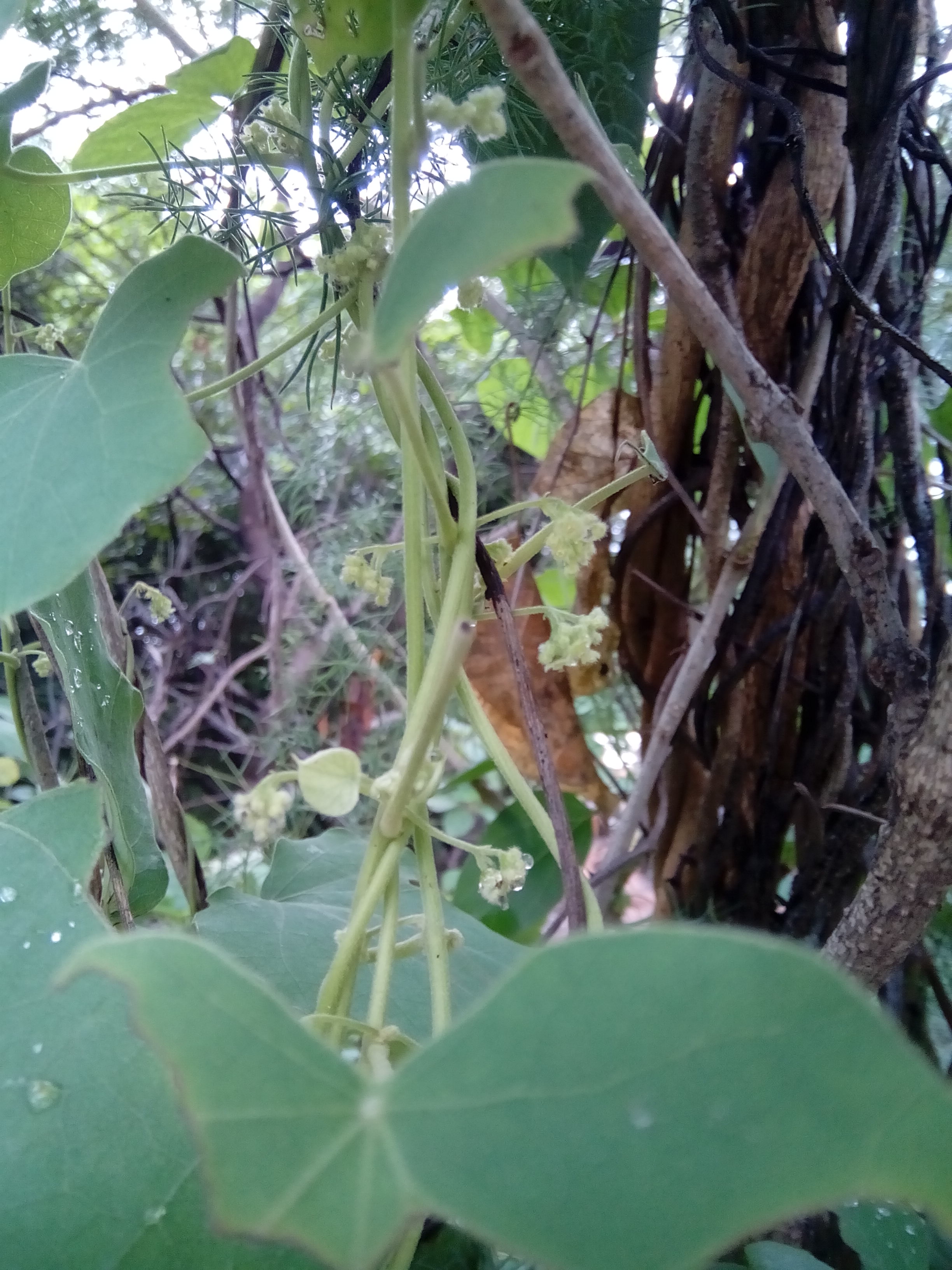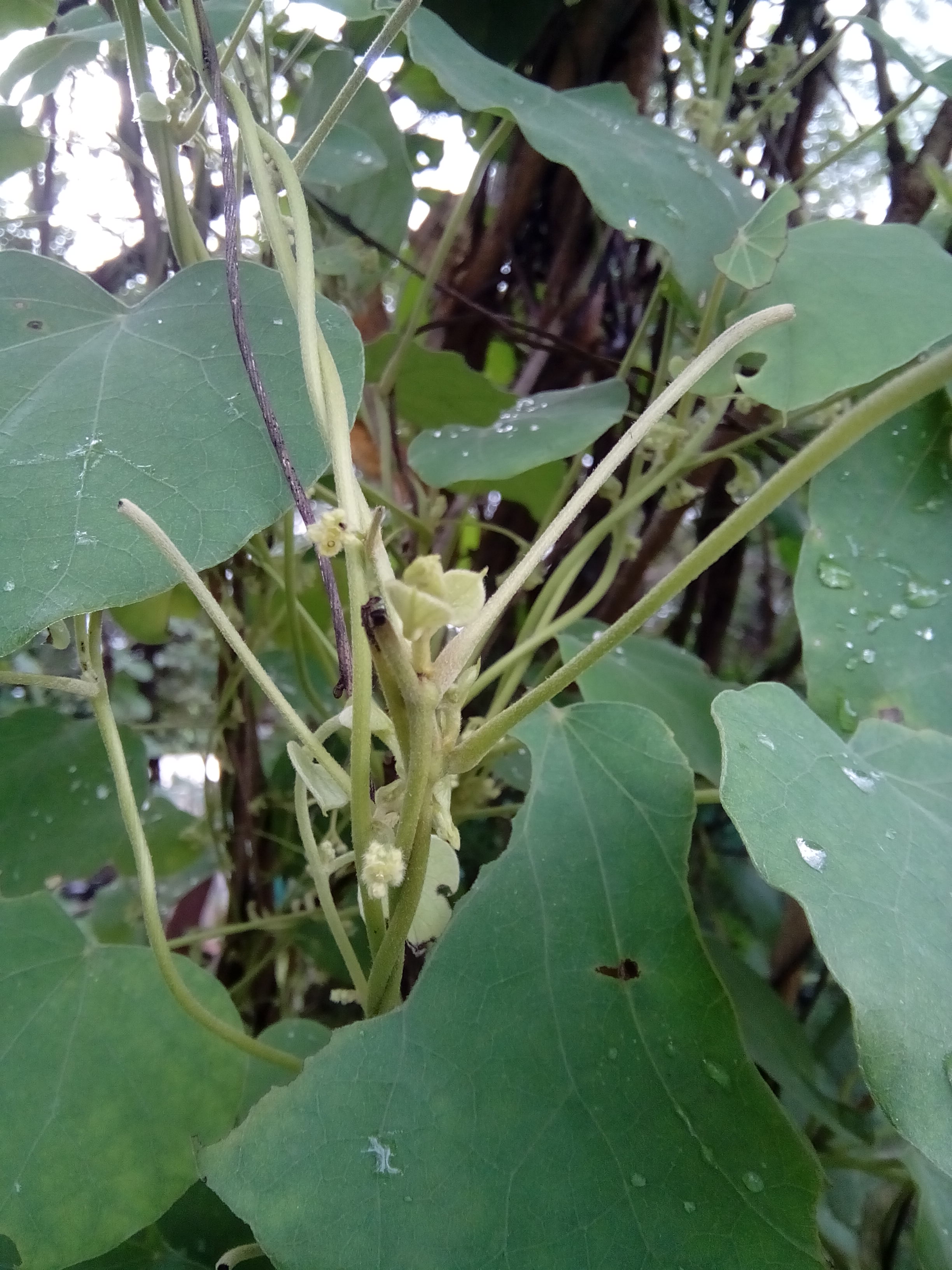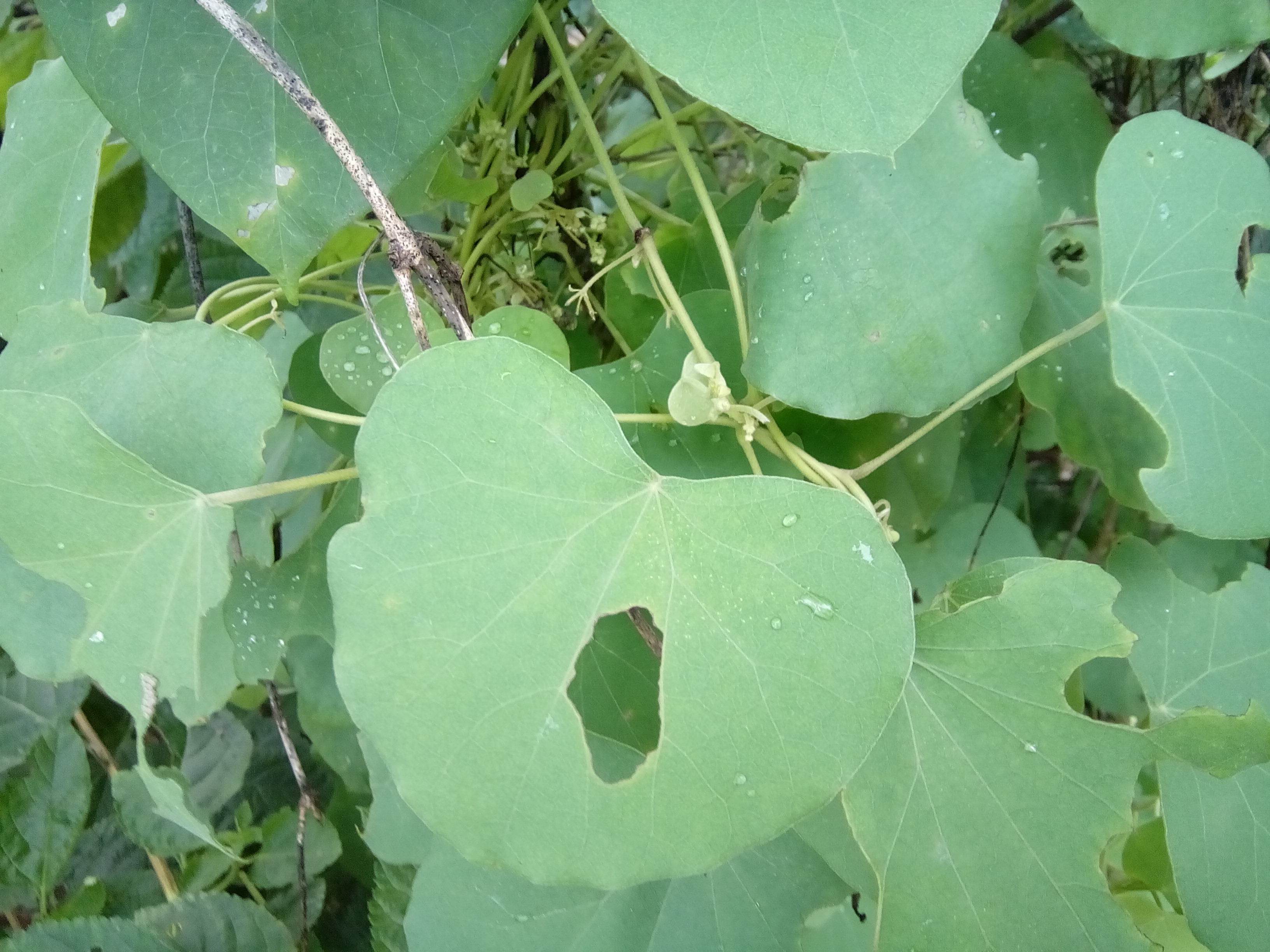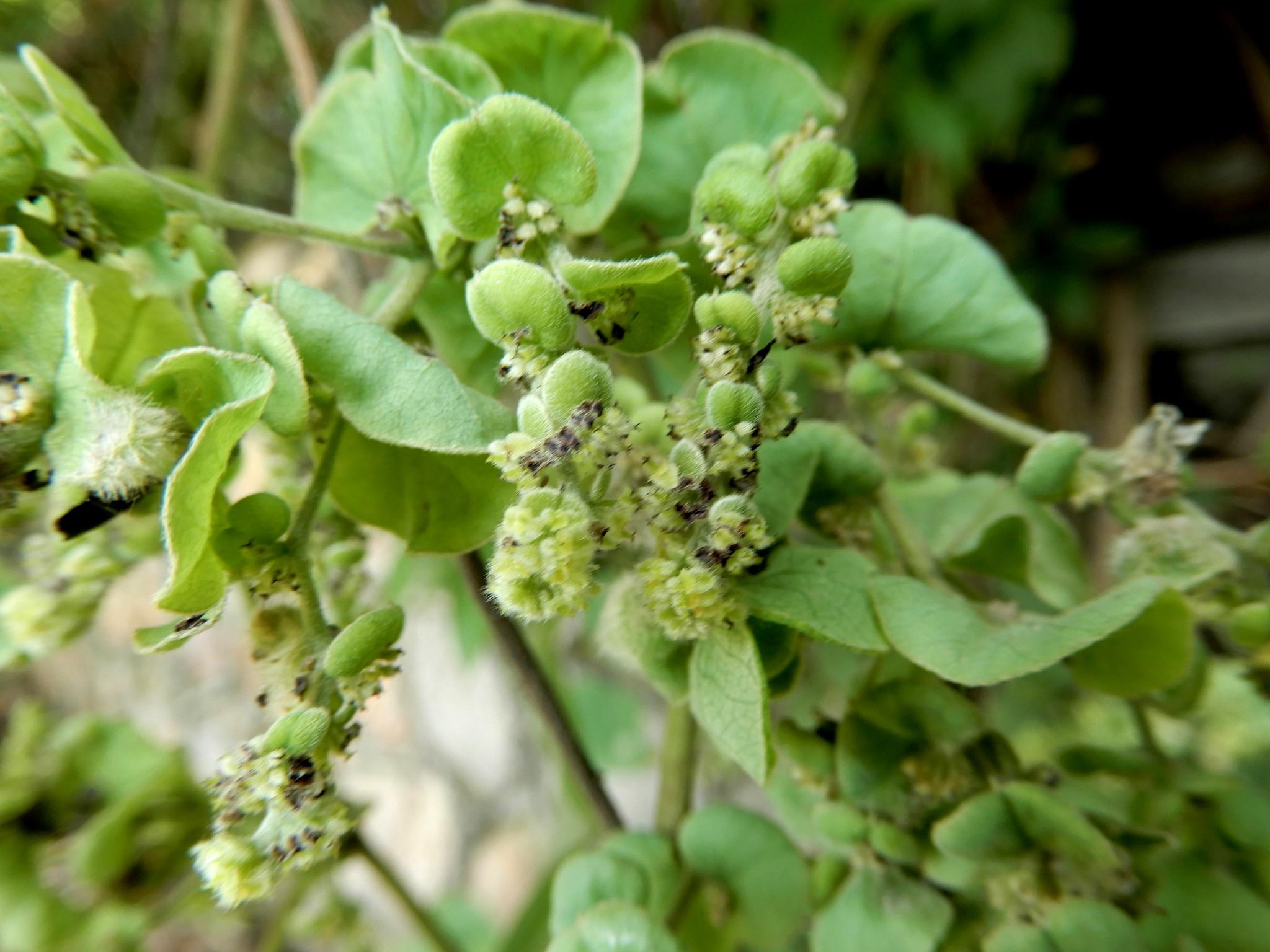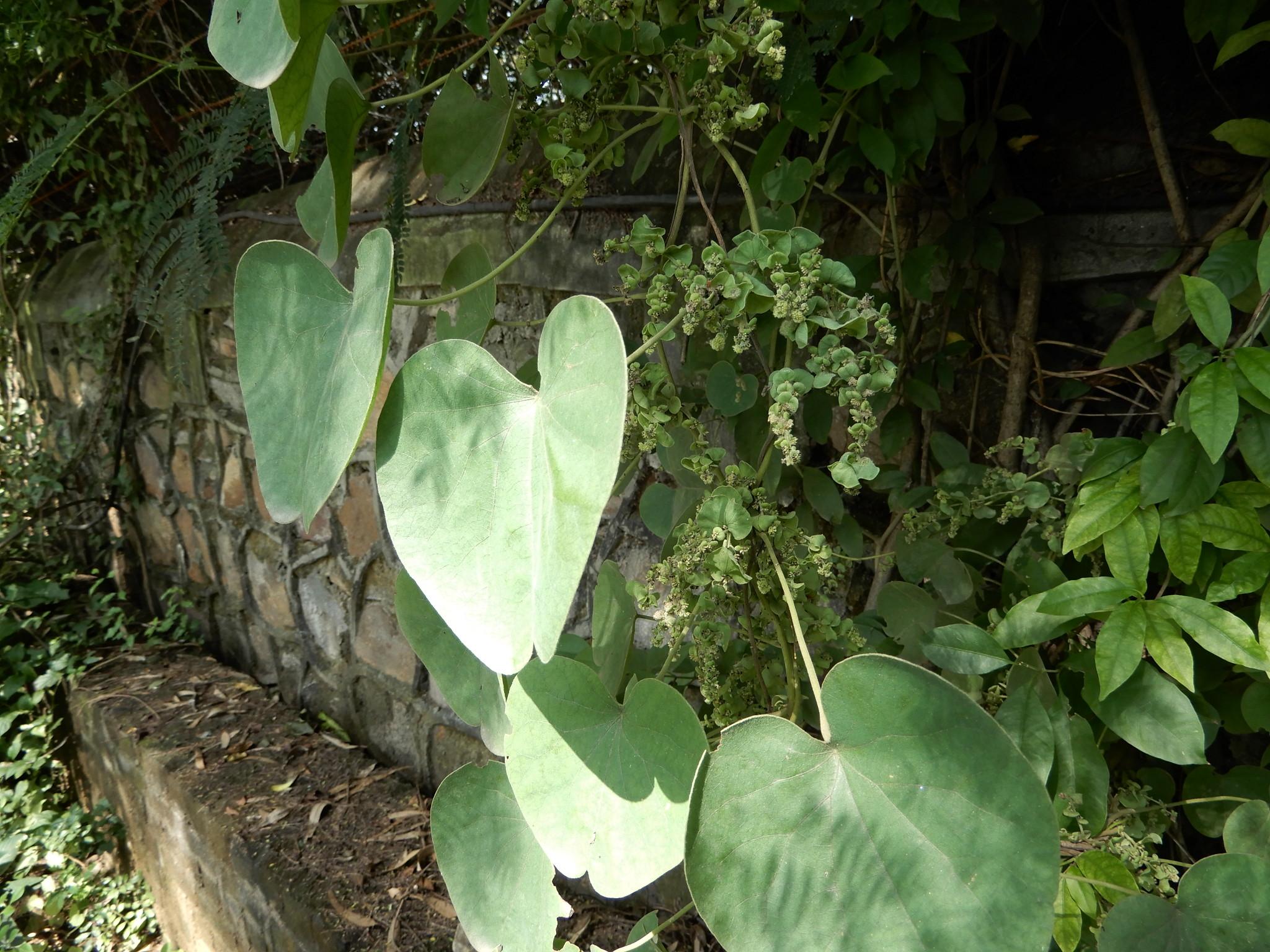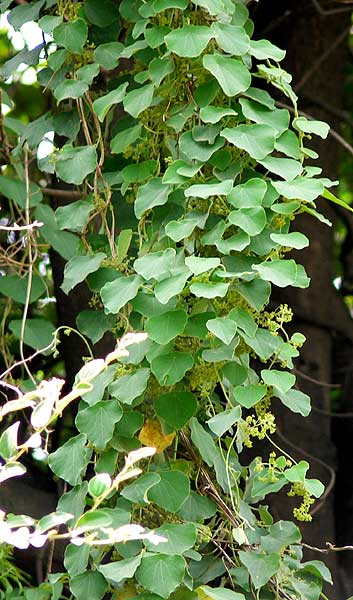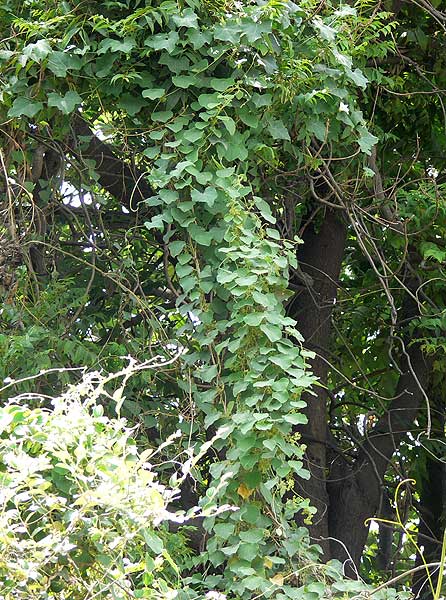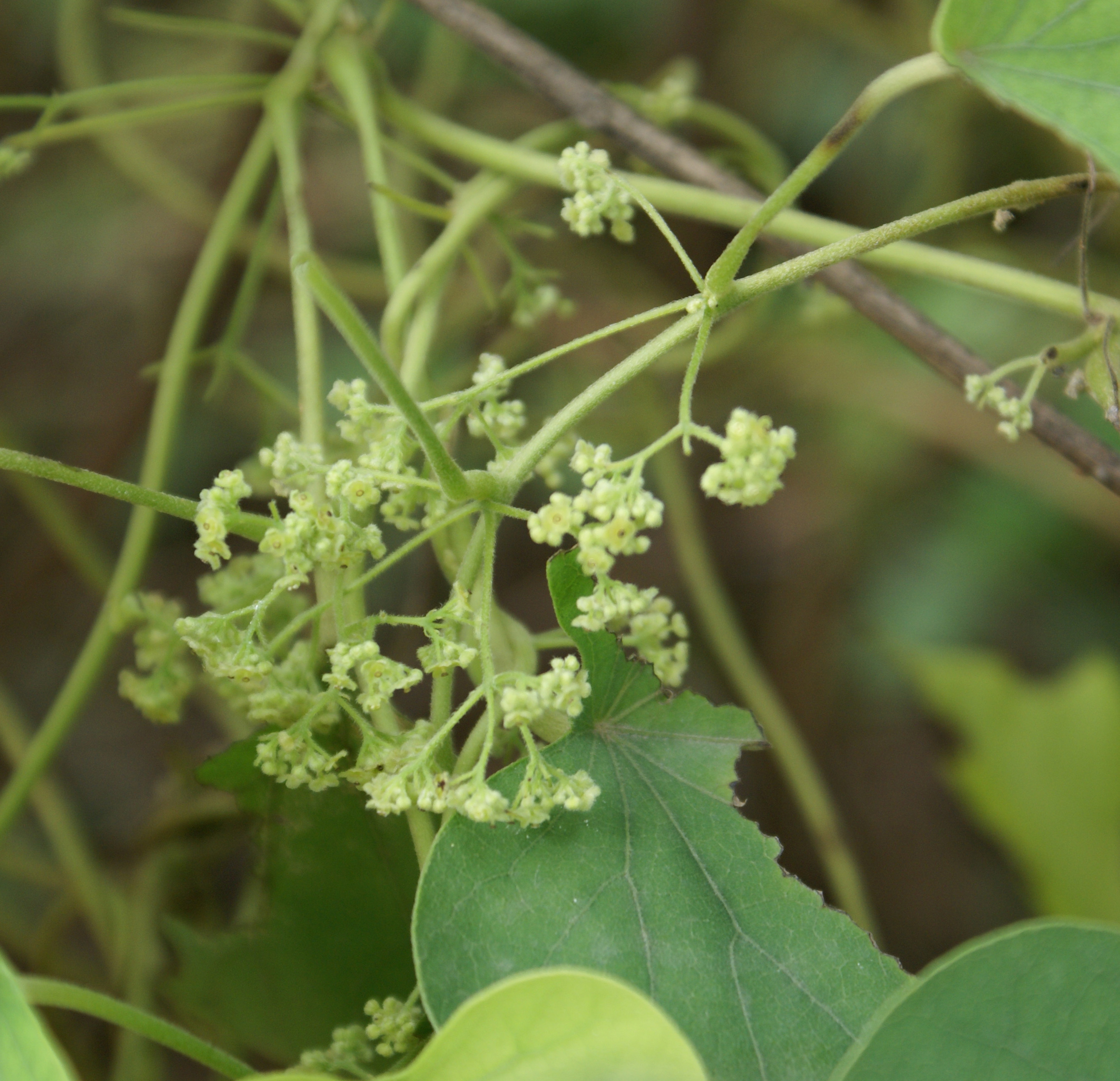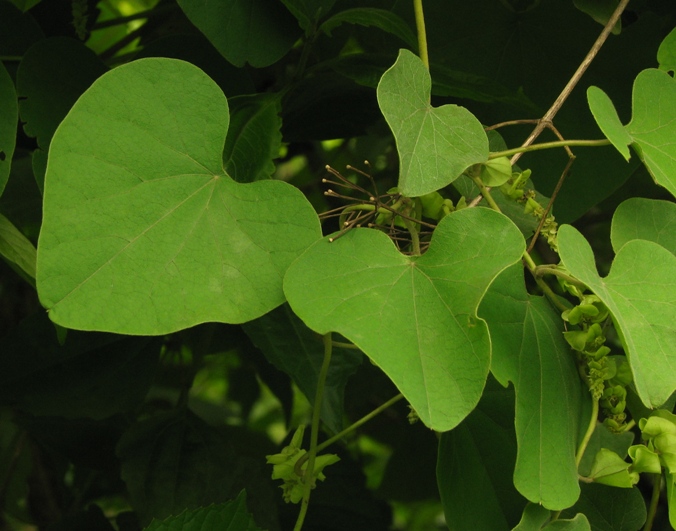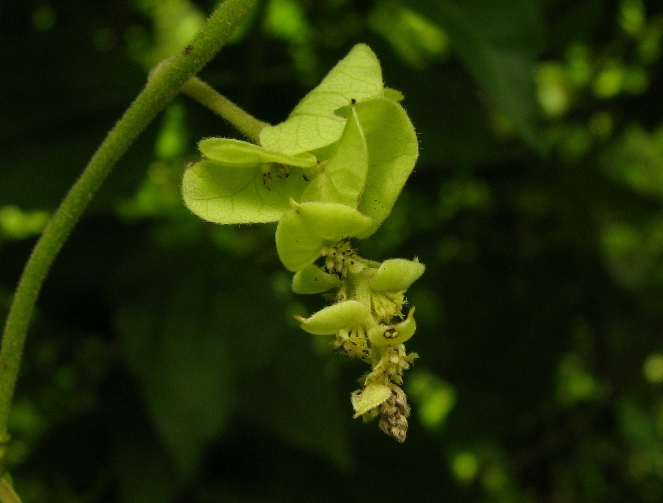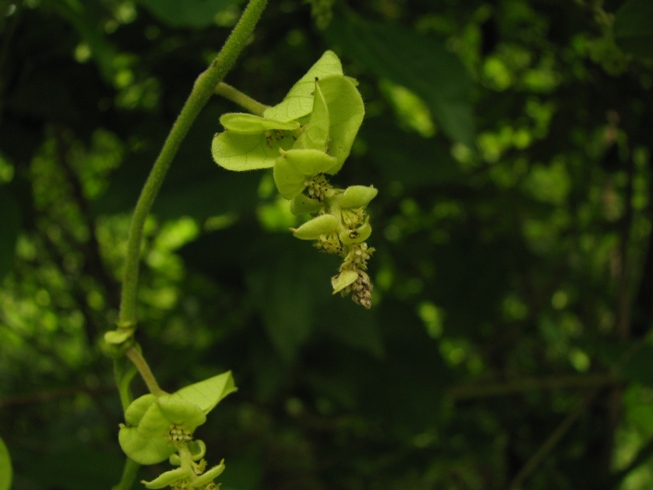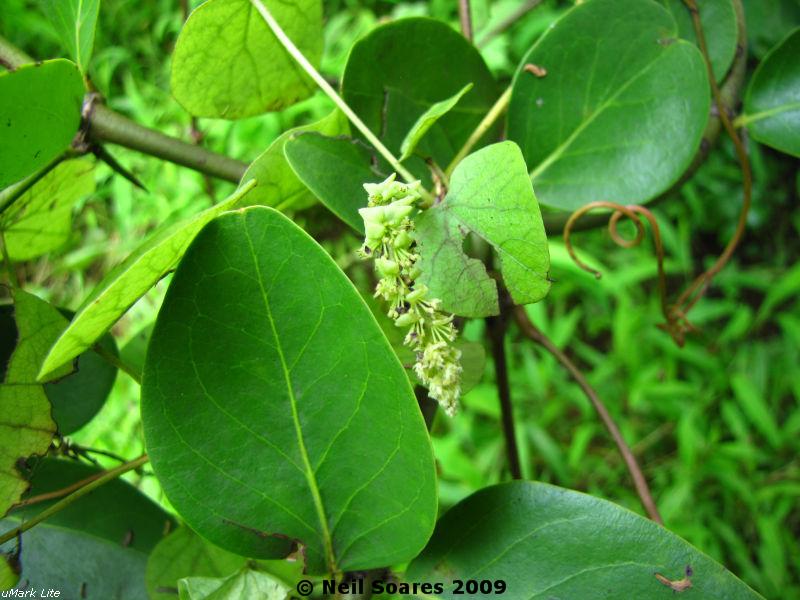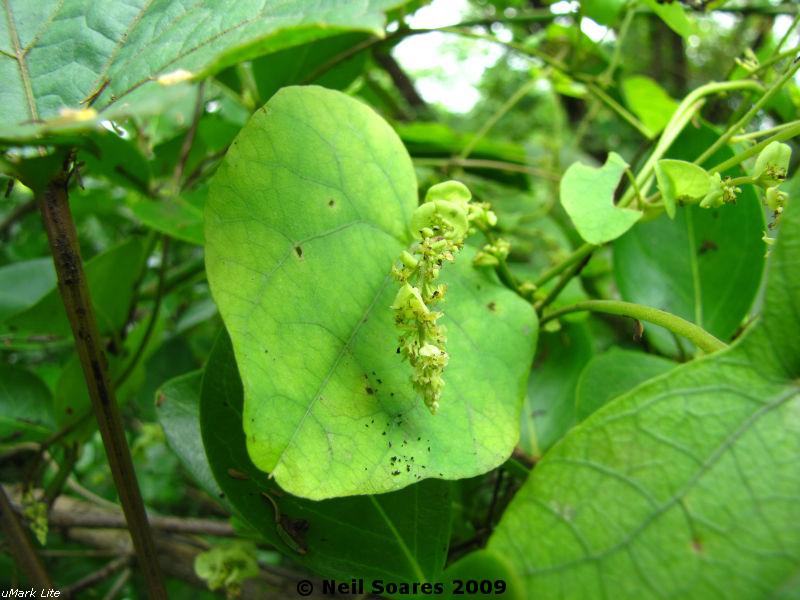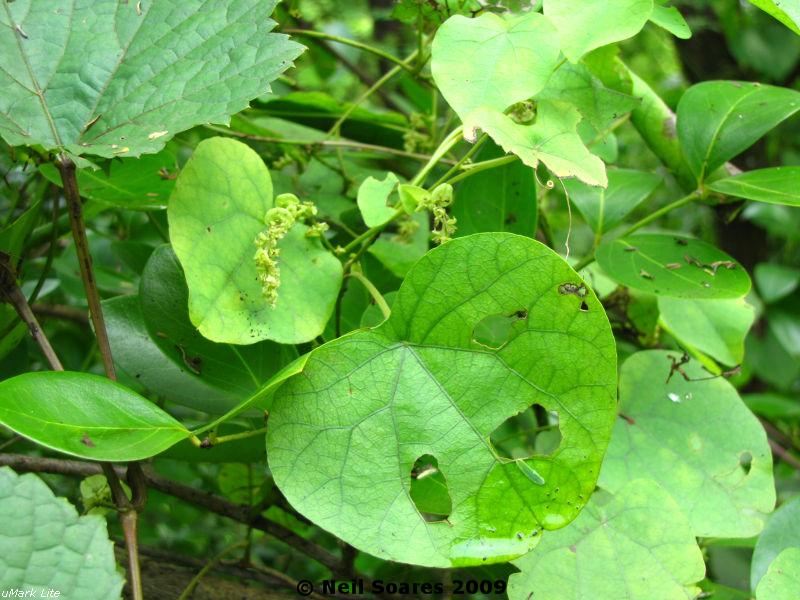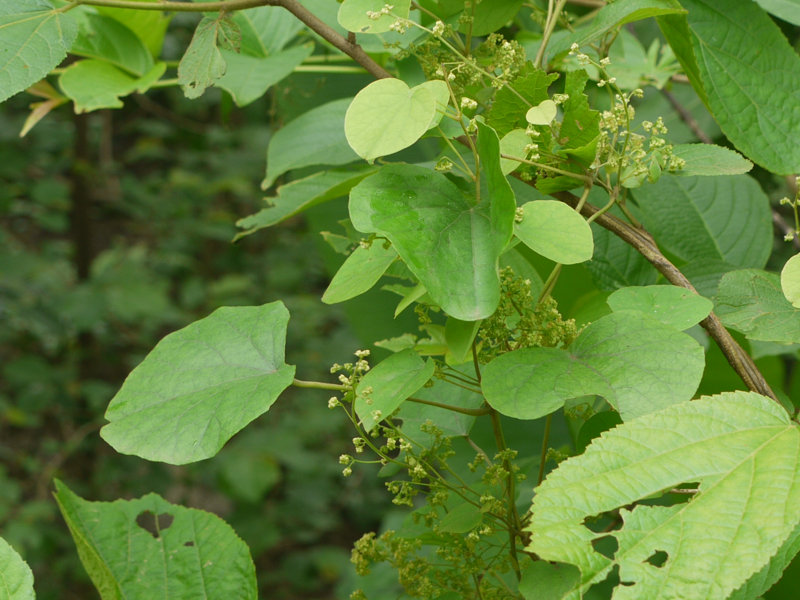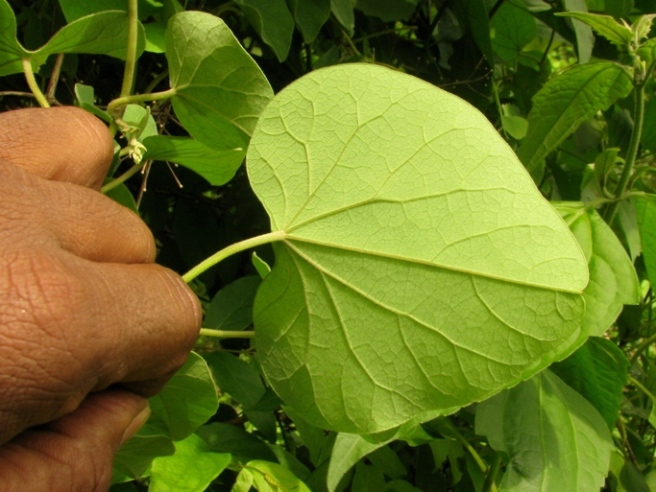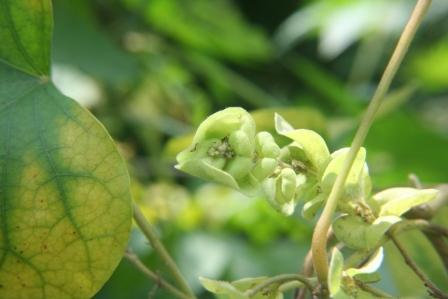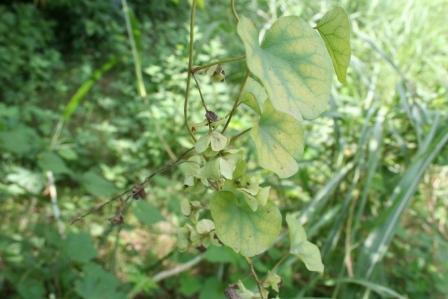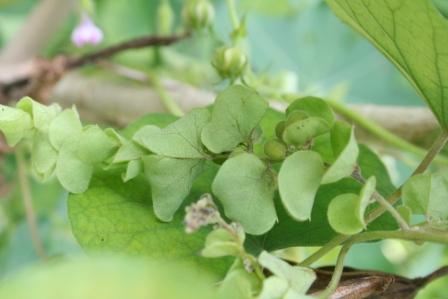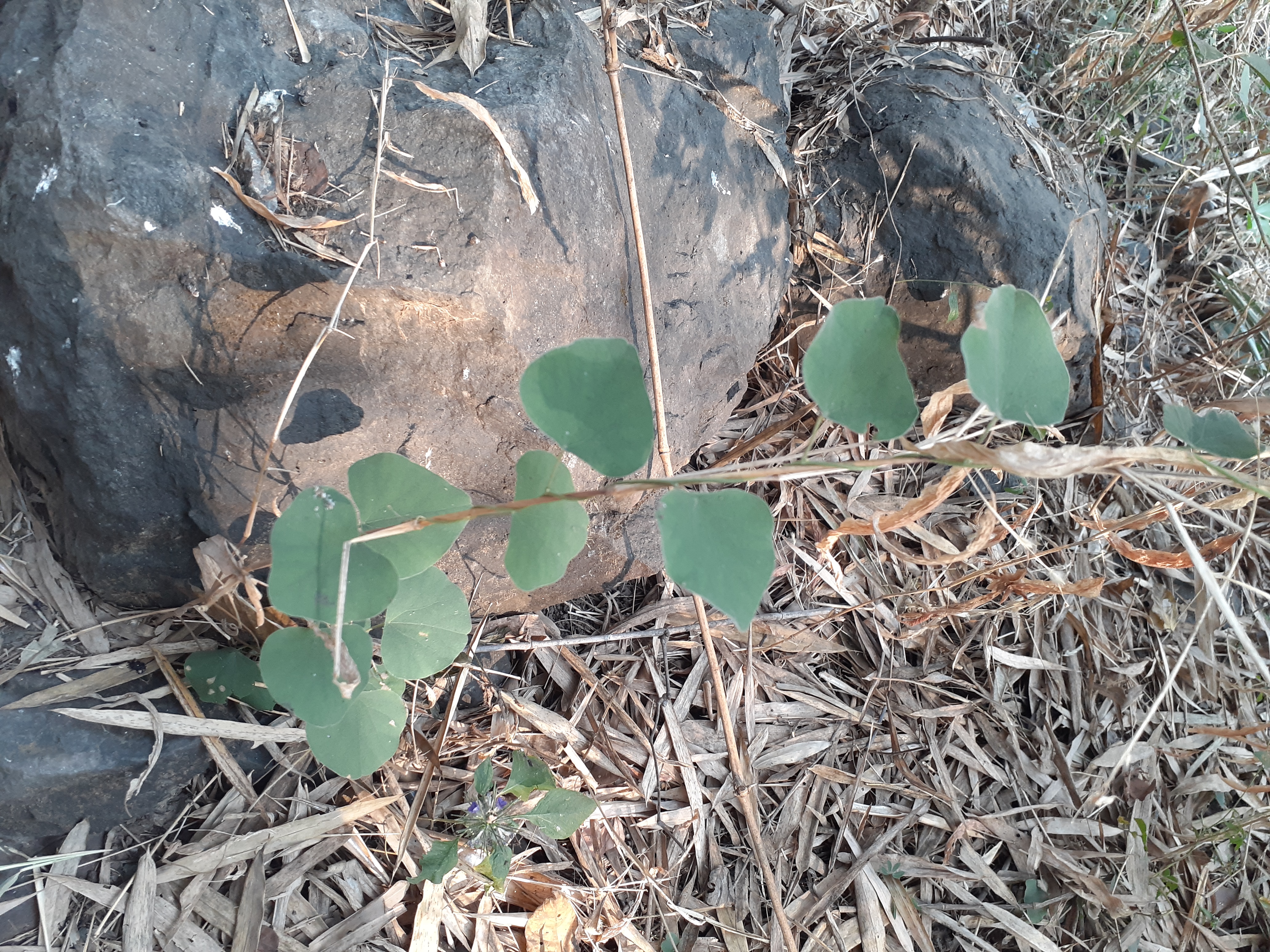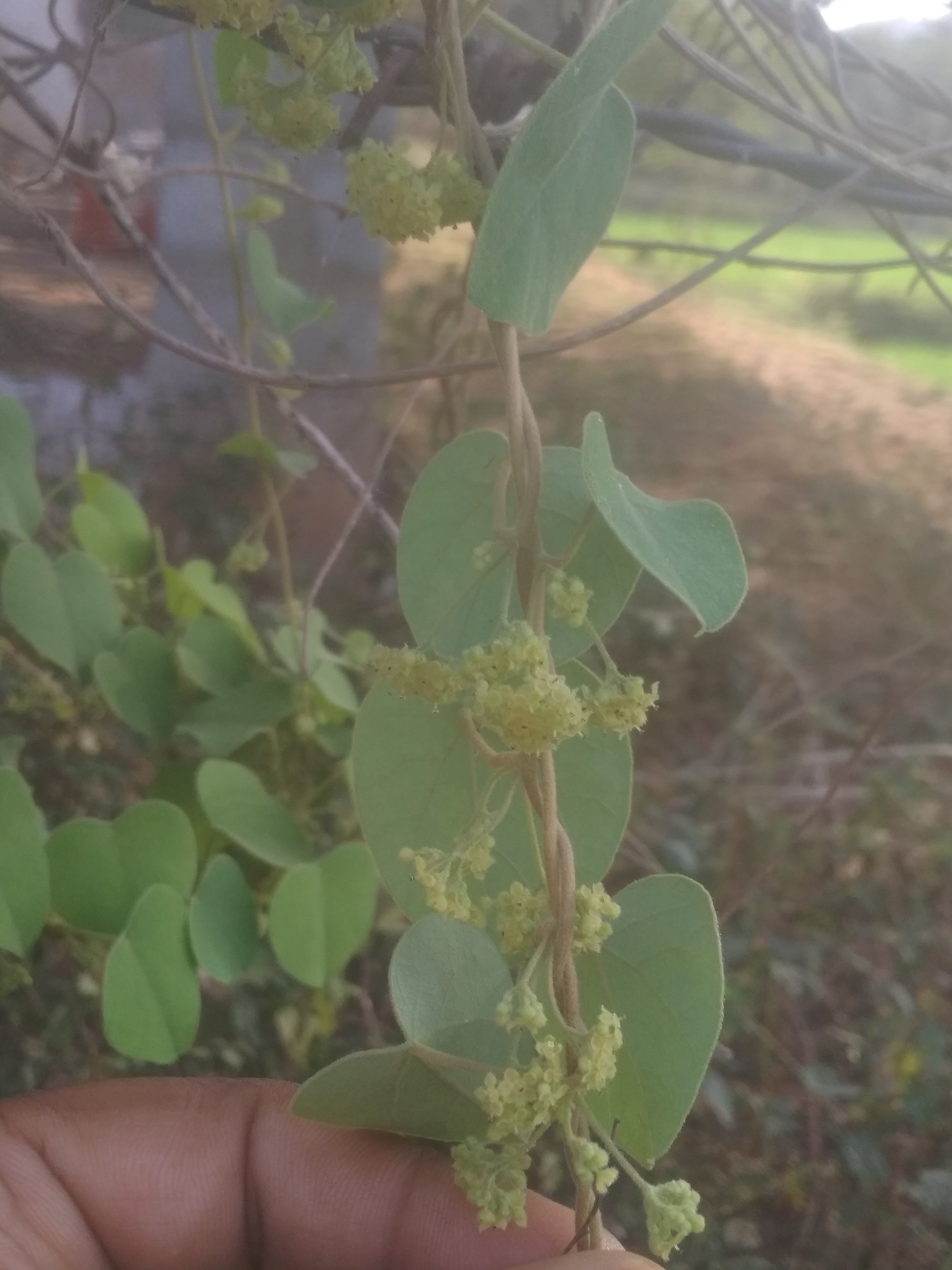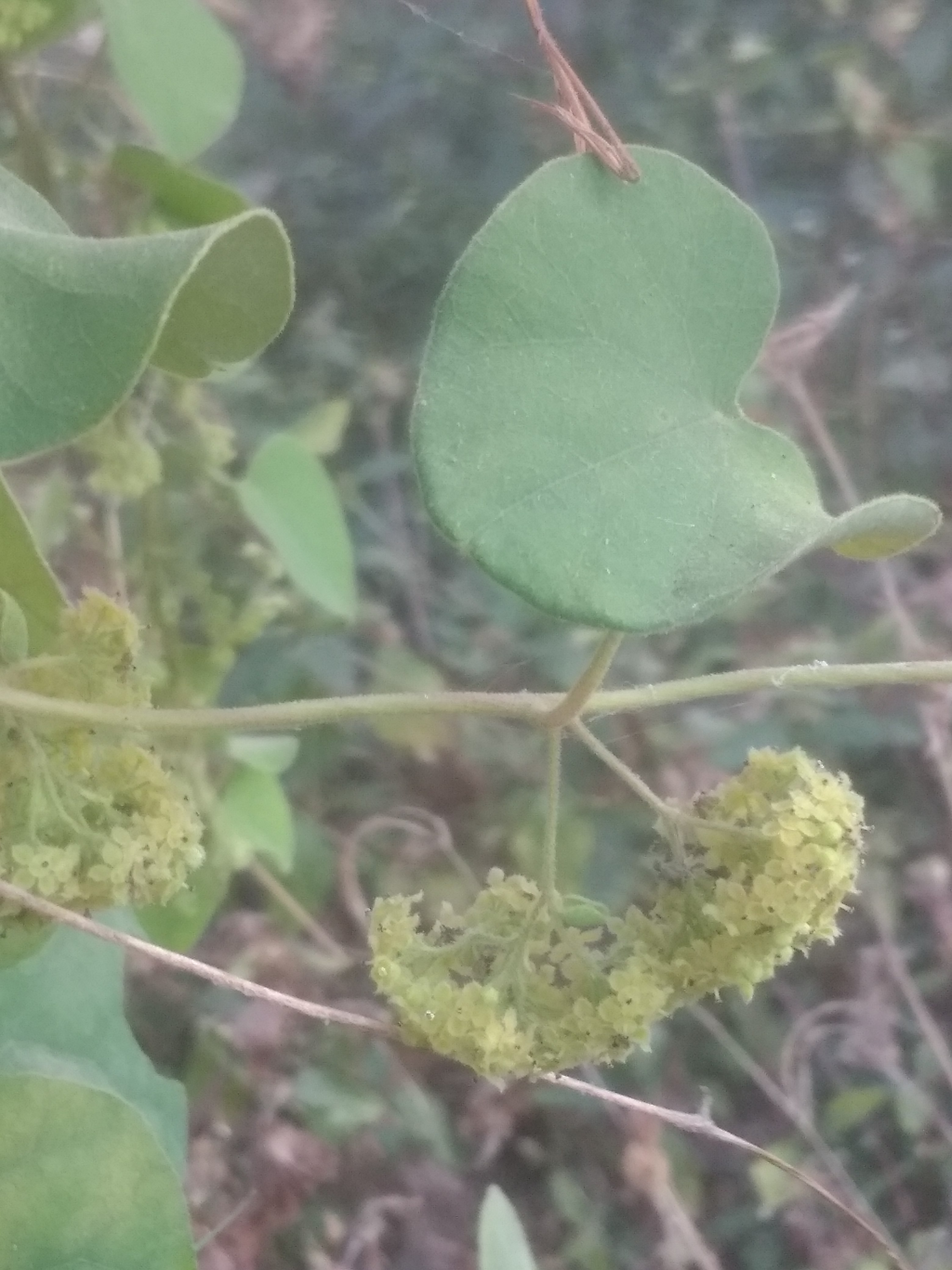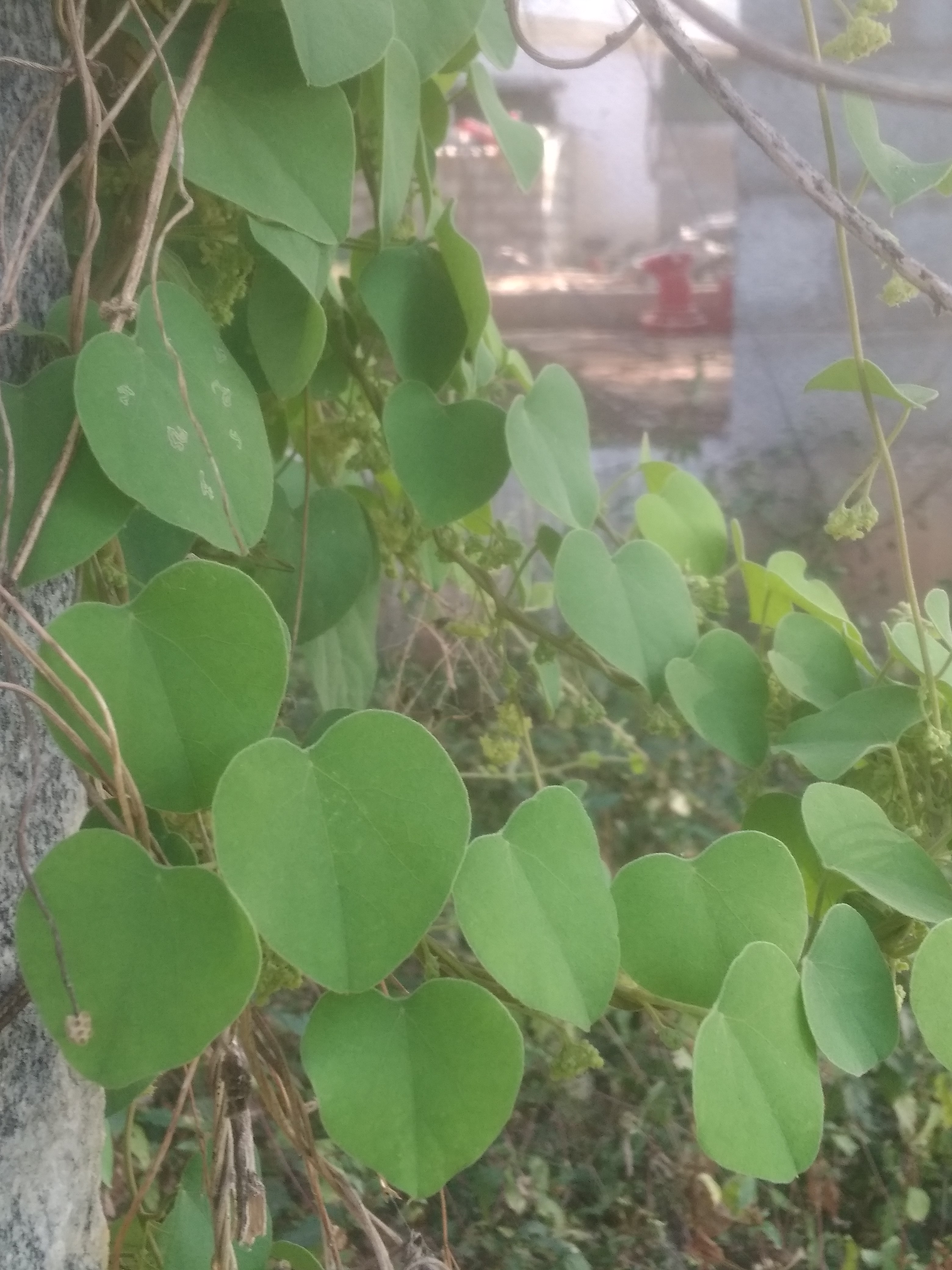|
Cissampelos pareira var. hirsuta (Buch.-Ham. ex DC.) Forman, Kew Bull. 22: 356 1968. (syn: Cissampelos boivinii Baill.; Cissampelos bojeriana Miers; Cissampelos convolvulacea Willd.; Cissampelos convolvulacea var. hirsuta (Buch. ex DC.) Hassk.; Cissampelos cordifolia Boj.; Cissampelos cumingiana Turcz.; Cissampelos hirsuta Buch.-Ham. ex DC.; Cissampelos madagascariensis Diels; Cissampelos nepalensis Rhodes; Cissampelos perrieri Diels; Cissampelos poilanei Gagnep.; Cissampelos subpeltata Thw.; Cocculus convolvulaceus Endl. ex Walp.; Dissopetalum mauritianum Miers; Stephania convolvulacea Miers) as per Catalogue of Life;
.
Cissampelos pareira Linnaeus var. hirsuta (Buchanan-Hamilton ex Candolle) Forman, Kew Bull. 22: 356. 1968 (Syn: Cissampelos hirsuta Buchanan-Hamilton ex Candolle) as per Flora of China;
.
Borneo, Philippines (common throughout), Sulawesi, Lesser Sunda Isl. (Lombok, Sumbawa, Flores, Wetar, Timor), Thailand, Moluccas (Halmaheira, Ceram, Tenimber, Aru), New Guinea, Australia (N-Queensland: Cape York peninsula), China (Guangxi, Guizhou, Yunnan), Pakistan (Sind, Pakistani Punjab, N.W. Frontier Prov., Hazara), Jammu & Kashmir (Kashmir, Poonch, Jammu), Ethiopia, Uganda, Kenya, Tanzania, Central African Republic, South Sudan, Zimbabwe, Mozambique, Zambia, Madagascar, Seychelles (introduced), Réunion, Myanmar [Burma] (Bago, Chin, Mandalay, Taninthayi, Yangon), Bhutan, Sikkim, Sri Lanka, India, Nepal, Vietnam, Laos, Cambodia as per Catalogue of Life;
.
India: Throughout in primary and secondary forests from plains to 1500 m. Himachal Pradesh, Punjab, Haryana, Rajasthan, Uttar Pradesh, Bihar, West Bengal, Sikkim, Assam, Arunachal Pradesh, Nagaland, Manipur, Mizoram, Tripura, Meghalaya, Orissa, Madhya Pradesh, Gujarat, Maharashtra, Andhra Pradesh, Karnataka, Tamil Nadu and Kerala; Pakistan, Nepal, Bhutan, Bangladesh to Malesia as per BSI Flora of India;
.
abuta, barbasco, false pareira brava, false pareira root, ice vine, midwife’s herb, pereira root, velvet leaf • Assamese: tubukilota • Bengali: kijri • Gujarati: વેણીવેલ venivel • Hindi: bhatvel, padh • Kannada: ಪರೆರಾ ಬೇರು parera beru • Khasi: jyrmi salla • Konkani: पहाडवेल pahadvel • Malayalam: മലതാണ്ടി malathaanti, പാടത്താളി paataththaali • Marathi: धाकटी पाडावळ dhakati padaval, लहान पहाडवेल lahan pahadvel, पहाडमूळ pahadmul • Nepalese: barel-panrhe, sulara • Oriya: ghodakur • Sanskrit: लघु पाठा laghu patha • Tamil: வட்டத்திருப்பி vatta-t-tiruppi • Telugu: పాట విష బొద్ది pata visah boddi;
.
As per efi thread : Cissampelos pareira and Stephania japonica belong to the family Menispermaceae
Both species are dioecious. In Stephania leaves are glabrous as are the stem as well
In Cissampelos leaves and stem tomentose In Stephania the petiole (leaf stalk) joins the leaf away from the edge / conspicuously peltate (resembles Cyclea peltata) generally triangular-rotund. In Cissampelos the petiole joins the leaf close to the edge In Stephania flowers arranged in stalked umbellate cymes
In Cissampelos Male inflorescences axillary, solitary or few fascicled, corymbose cymes and pubescent whereas, female inflorescences thyrsoid, narrow; .
Our species- Cissampelos pareira or Cissampelos pareira var. hirsuta : 3 posts by 2 authors.
Pl. see various references at Cissampelos
Some mention Cissampelos pareira, while others mention Cissampelos pareira var. hirsuta. GRIN gives Cissampelos pareira L. with no range in India.
Three efloras & most of the regional floras talk of Cissampelos pareira var. hirsuta only.
In view I shall be taking our species as Cissampelos pareira var. hirsuta only.
If there is some other view, pl. let me know. Yes C. pareira var. hirsuta also according to Flora of India.
MBNN Fortnight-sk10 Jhargram-sk-Oct-31 (Menispermaceae) Cissampelos pareira L. : 5 posts by 3 authors. 5 correct images as above.
This is from a Govt. park and there was no name plate. Instead there was a plate bearing the name Argyreia nervosa. I was confused for a while. I am uploading the entire series of snaps I took there to show which one (leaves) belongs to Argyreia.
It is interesting that … has photographs of Cissampelos pareira with peltate leaves as in FoP while var. hirsuta of FoC does not have! I think the name board is meant for the sapling (cordate leaves with acuminate tips), which looks like Argyreia nervosa. Yes … Very beautiful pics … Only the first picture belongs to the placard, as … have said.. thanks for posting.. Yes Sir, i was very puzzled initially! Paschim Medinipur : Cissampelos pareira L. : 1 post by 1 author. Attachments (2). Menispermaceae, Berberidaceae, Nymphaeaceae & Nelumbonaceae Fortnight 11-24Oct.2014: Cissampelos pareira L (Menispermaceae)from Assam KD 04 Oct : 2 posts by 2 authors. 9 images.
Attached images are Cissampelos pareira L from Assam Yes, I think these are the female flowers of C. pareira var. hirsuta. . Unknown climber from Kamrup district, Assam : Attachments (9). 7 posts by 5 authors.
Attached images are unknown climber collected from Kamrup district Assam. Please ID the plant.
Date :15.06.2013
Location: Kamrup district, Assam
Family : Unknwon
Genus & species : Unknown
Habitat: Grows wild on fences
Habit : Climber I hope my species is Cissampelos pareira L. (Menispermaceae).
Yes, I think it is Cissampelos pareira
MBNN Fortnight :: Menispermaceae:: Cissampelos pariera var. hirsuta from Panipat-NS 09 : Attachments (6). 2 posts by 2 authors.
This is a frequent climber of north Indian plains as well as lower hills..
Cissasmpelos pariera var. hirsuta .. recorded from Panipat Nice … Climber for ID from Uttarakhand-GSDEC11 : 3 posts by 2 authors. Attachments (2)
Kindly help in the ID of this climber photographed from near Ukhimath in Uttarakhand on May 30, 2013 Resemble to Cissampelos pariera. Leaves eaten by insects at margin? You may be right … Fwd: Climber id from Bangladesh sm288 : 3 posts by 3 authors. Attachments (5) Cissampelos pariera, family Menispermaceae. In the last picture there is a fruit. do you have close ups of it and size of leaves and the fruits please Stephania japonica ?? : 7 posts by 4 authors. Attachments (10)
Sharing some pictures of Stephania japonica ?? shot on 9 August at Mudkhu, Nepal at 5000 ft. Does not match with images of Stephania japonica
Pl. check for Cissampelos species or some other genera ? Cissampelos pareira ! Yes, male flowers. Though keys are based on flowers (and you are lucky to have the plant flowering) a practical tip in non-flowering state are the leaves which are more broader than long, base cordate and pubescent on both surfaces. Probably male inflorescence of Cissampelos pereira (Menispermaceae). Sending photos of both male and female inflorescences. Plants were growing in JNU campus, New Delhi. ID request 24092011PC1: 4 images.
Please identify this climber found growing wild in JNU campus, Delhi. Length of the leaves is 5-8cm, inflorescence is 3-10 cm.
Yes Cissampelos pareira, a highly medicinal plant. Flora of Panipat: Cissampelos pareira from Sodhapur Panipat: 8 images. Flora of Chakrata: Cissampelos pareira from Chakrata Kalsi road: 6 images. ID27072012PHK1: 3 images. Id Please
A climber with cordate and very thin leaves At Mahad, maharashtra Its Cissampelos pareira of menispermaceae family….. its male & female plants are separate ..this plant is female plant Climber For ID : SGNP,Mumbai : 020713 : AK-1 : Attachments (2). 3 posts by 2 authors. Cissampelos pareira L. var. hirsuta (Ham. ex DC.) Forman Climber for ID : 03092013: RV 1 : Attachments (3). 4 posts by 3 authors. I think it is Cissampelos pareira Agree with Cissampelos pareira, The next post is the same plant. I was confused because of the flowers……..thank you so much for the help. Climber for ID : 03092013 : Attachments (3). 4 posts by 3 authors. I think these leaves are also resembling Cissampelos pareira. Cud this be female flower of the same plant?? A reply from another thread:
“Agree with Cissampelos pareira, The next post is the same plant.” Requesting ID of this climber – Mumbai :: 16092013 :: ARK-02 :: September 2013 : Attachments (2 + 1). 6 posts by 4 authors. Cissampelos pareira var. hirsuta. Thanks … for the quick ID… However, the leaves of this climber are peltate I think…. Could this be something else? Cissampelos pareira for me too. Cissampelos pareira Thank you … for ID and the reference pic as well…… I am convinced now 🙂 Could this be a Stephania sp.? Cissampelos pareira var. hirsuta. SGNP, Aug 2014 :: Requesting ID of this climber :: ARKSEP-03 : 3 posts by 2 authors. Attachments (4). This is the female plant of Cissampelos pareira L. MBNN Fortnight :: Menispermaceae :: Cissampelos pareira :: SGNP :: ARKOCT-08 : 1 post by 1 author. Attachments (6). Menispermaceae, Berberidaceae, Nymphaeaceae & Nelumbonaceae Fortnight 11-24Oct.2014: Cissampelos pareira var. hirsuta (Menispermaceae) from Uttarakhand_DSR_1 : 4 posts by 4 authors. Attachments (3). Thanks …, a nice plant to begin with, used in medicines.. A complete set – showing male flowers, female flowers and fruits! agree with … Menispermaceae, Berberidaceae, Nymphaeaceae and Nelumbonaceae Fortnight :SN 07 : 1 post by 1 author. Attachments (1). MBNN Fortnight :: MENISPERMACEAE :: Cissampelos pareira :: # RVS-Oct 06 : 2 posts by 2 authors. 2 images. Cissampelos pareira L. SK345JAN27-2017:ID : 8 posts by 3 authors. Attachments (10) Location: Raniban, Balaju, Nepal
Altitude: 4900 ft.
Date: 26 August 2016
This should be Cissampelos pareira Thank you. Cissampelos pareira L. (accepted name) Flora of Panipat- Cissampelos pareira: 1 image.
Cissampelos pareira from Panipat Jatal Road
What is the difference this Cissampelos pareira and Stephania japonica in the same family?
Cissampelos pareira and Stephania japonica belong to the family Menispermaceae In Stephania leaves are glabrous as are the stem as well
In Cissampelos leaves and stem tomentose In Stephania the petiole (leaf stalk) joins the leaf away from the edge / conspicuously peltate (resembles Cyclea peltata) generally triangular-rotund. In Cissampelos the petiole joins the leaf close to the edge In Stephania flowers arranged in stalked umbellate cymes
In Cissampelos Male inflorescences axillary, solitary or few fascicled, corymbose cymes and pubescent whereas, female inflorescences thyrsoid, narrow Some useful Links:
Stephania japonica hear http://www.efloras.org/florataxon.aspx?flora_id=2&taxon_id=200008451 Cissampelos pareira
http://www.efloras.org/florataxon.aspx?flora_id=2&taxon_id=242313190 24112014GSNOV01 climber for ID from Rudrapryag, Uttarakhand-GSNOV01 : 6 posts by 5 authors. Attachments (2).
Please help in the ID of this climber photographed from near Rudrapryag in Uttarakhand on May 30, 2013 Seems Menispermaceae, leaves will be helpful in determining. Here it is … Missed earlier due to duplication I hope Cissampelos pariera .. I follow … in identifying the Plant as Cissampelos pariera is it also a cuadiciform plant? ANMAR08/08 Please identify this climber : 3 posts by 2 authors. Attachments (5)
Family: Menispermaceae It is Cissampelos pareira- Patha, Patindu known commonly & locally. Belongs to family Menispermaceae. This climber on fences, trees and shrubs is fairly common in Delhi. I thought it to be Cissampelos (leaves look similar without pubescence) till I saw its flowers. Unfortunately its floral structure does’nt permit me to even identify its family. Help in identification saught.
it may be species of Menispermaceae family ?// may some one of Cissampelos
That is what I also thought initially. As mentioned in my mail I had even identified it as Cissampelos pariera, but changed my mind after seeing flowers. There are female flowers with hairy ovary with trifid style with 3 stigmas. There is no trace of perianth. I could see just two bracts, one outside another subtending the ovary. I am not even able to place the family. it is Cissampelos parriera female plant. Thanks … I am happy my original identification stands. Thanks for providing details, I have subsequently checked from efloras. Cissampelso pareira flowers – indiantreepix | Google Groups : 5 posts by 4 authors. Attachments (6) To me they look female flowers. I am uploading one with male flowers separately. In my observation there are two types of Cissampelos pareira in south India. One is having glabrus leaves and other is pubescent. But the floral characters are same. I have worked on it and finally abandoned. I would look it again when I will be back to India. In India, if i am right, only the var. hirsuta has thus far been reported (leaves hirsute or glabrescent). If you check Flora of China, it reads as “Cissampelos pareira var. pareira, with glabrous leaves, was described from the West Indies and seems to be restricted to that region, whereas var. hirsuta is pantropical”. If this is the only difference between var. hirsuta and the typica, then your glabrous plant would be var. pareira, perhaps a new record to India. I know it is the typical variety. I thought it would have published from India.
If any publication in India has reported (and I know many have) C. pariera it automatically means we are refering to var. pariera. It is an automatically created name- an autonym. Only var. hirsuta needs to be mentioned described, and reported separately. SK1093 20 APR-2018 : 4 posts by 2 authors. Attachments (9)
Location: Godawari, Nepal
Date: 18 April 2018
Altitude: 5000 ft.
Habit: Wild Cissampelos pareira var. hirsuta (Buch.-Ham. ex DC.) Forman ??
To me also appear close to images at Cissampelos pareira var. hirsuta (Buch.-Ham. ex DC.) Forman Cissampelos sp. ? : 5 posts by 2 authors. Attachments (3)- 1 Mb each.
I have similar collection from Hyderabad, aug2016.
But inflorescence is different, may be Cissampelos sp. it is the male plant of Cissampelos pariera/ the image is not good
It is Cissampelos pareira, Male and female plants are separate, so inflorescence also vary.
Flemingia chappar from Delhi : 11 posts by 4 authors. Attachments (2)
Flemingia chappar
seen blooming in October at Sundar Nursery, Delhi
I feel it should be Cissamoelos pariera only.. i think … is on the right tract i just sent in the descriptions from efloras of harvard univ projects for keeping in our website Thank you all for the response. Nidhan may be right, but let me point out the reason for my conclusion. Firstly, Flemingia macrophylla and Flemingia chappar Benth. are different species, acording to Catalog of Life. And according to FOC:
1. Flemingia chappar Buchanan-Hamilton ex Bentham in Miquel, Pl. Jungh. 244. 1852.
墨江千斤拔 mo jiang qian jin ba
Maughania chappar (Buchanan-Hamilton ex Bentham) Kuntze.
Shrubs, erect, ca. 1 m tall. Branchlets slender, densely brown villous. Leaves simple; stipules narrowly ovate, ca. 2 mm, deciduous; petiole ca. 1.5 cm, densely deciduous brown villous; leaf blade orbicular-cordate, 4-4.5 cm, papery or thinly leathery, glabrous or sparsely pubescent
Secondly, I could not get a good close shot of the flowers, and from my fuzzy pictures they appeared pea-shaped, so I looked for Flemingia species.
Thirdly, the leaves don’t look prominently peltate. I am attaching a picture to show that.
Maybe I will go and have a shot at the flowers again.
However, the plant did look like a climber, which was puzzling to me.
Attachments (1)
Flemingia chappar is an erect shrub. We have one image of it in eFI photographed in Rajaji National Park, Uttarakhand. You were right! It is Cissampelos pareira only. I went today and photographed the flowers. I am attaching a pic. that’s good am glad it was where you could get to it again. hope you took many pictures. secondly, do you ever take pics of the backside of the leaves? Yes, I do click the back of the leaves, unless I forget to do it. Here is the one for this plant.
ID request, Flora of Uttarakhand (200609SS1) – indiantreepix | Google Groups . Plz id climber : 9 posts by 5 authors. Attachments (1) – 5 mb.
Please identify the climber, Thane, yeoor, 26 January
I think this is Cocculus hirsutus (L.) Diels as ided by … in another thread. No way sir Ji, It’s not et all Cocculus, It’s Stephania or Cissampelos only, Stephania only, …, Cissampelos could be a possibility – I request … to show a close up of a leaf. I think it is Cissampelos.
We have only one species of Cissampelos so far in efi site: Cissampelos pareira var. hirsuta
I think it matches with this.
Please identify the climber : 7 posts by 4 authors. Attachments (1) – 5 mb.
Plz id the climber, Thane, yeoor, 26 January Looks like Cocculus hirsutus.
Stephania sp. Only Menispermaceae. I think more likely to be Cocculus hirsutus (L.) Diels rather than Stephania japonica as per images and details herein.
I attached with Stephania only, …, for this pic. Thanks … The leaves and general form of climber resembles the very commonly growing Cocculus hirsutus in that area where … has clicked the picture.
Requesting … to attach any other picture of the posted plant if available, else please revisit the site whenever next possible, and take close-up picture of one leaf of the plant, and post it here.
As per id by … in another thread, it is Cissampelos
We have only one species of Cissampelos so far in efi site: Cissampelos pareira var. hirsuta
I think it matches with this.
Plz identify the plant name available in somanahalli Bangalore south thaluk
It is Cissampelos peraira (Pada, Velvette leaf). Tuber of this is used in Indian system of medicine for fever etc. yes it is Cissampelos peraira . Need help in ID of Creeper spotted in Yeoor SGNP area, Dist. Thane, Maharashtra August 2014 : 8 posts by 3 authors. Attachments (1)
Cissampelos pareira L. ??
Yes I got the ID from friends. I am looking at Eflora as source of ID for my spotted plants in India. I could not find reference of some plants so need to post for ID help. The guidelines are look complicated. I am not botanist. But making collection of “Plants and Arthropods relationship” across India and mainly Sahyadri Mountain.
Thanking you.
If I give details like Like Date Place District State and type of habitat will be enough to inform with images? Thanks, …, for your interest in Plants and Arthropods relationship.
Yes, it will be fine if you give details like Date Place District State and type of habitat . Jawhar near Nashik, MH :: Cissampelos for validation :: ARK2021-049: 4 images. This was clicked at Jawhar near Nashik, MH in July 2021.
Guessing this to be Cissampelos pareira var. hirsuta. Requested to please validate. Yes, … Seems to match as per images at Cissampelos pareira var. hirsuta . Climber for ID : Borgad Conservation Reserve : Nasik : 18SEP21 : AK – 019: 5 images.
A delicate climber seen today (18.9.21) at the base of Borgad. New for me. Cissampelos pareira . Menispermaceae: Cissampelos pareira L.: last two correct images.
location/date: (jp1, jp2) Barha, Jabalpur Distr., Madhya Pradesh, October 1994, (vine with inflorescences) Nandi Hills, Bangalore, Karnataka, July 1997 . Minespermaceae: Cissampelos pareira: 1 high res. image. .
051025PKD2: Id pls collected from Nayagargh Odisha on Oct 2025: 4 high res. images.
Cissampelos pareira var. hirsuta (Buch.-Ham. ex DC.) Forman . References:
|
Cissampelos pareira var. hirsuta
Updated on October 10, 2025

